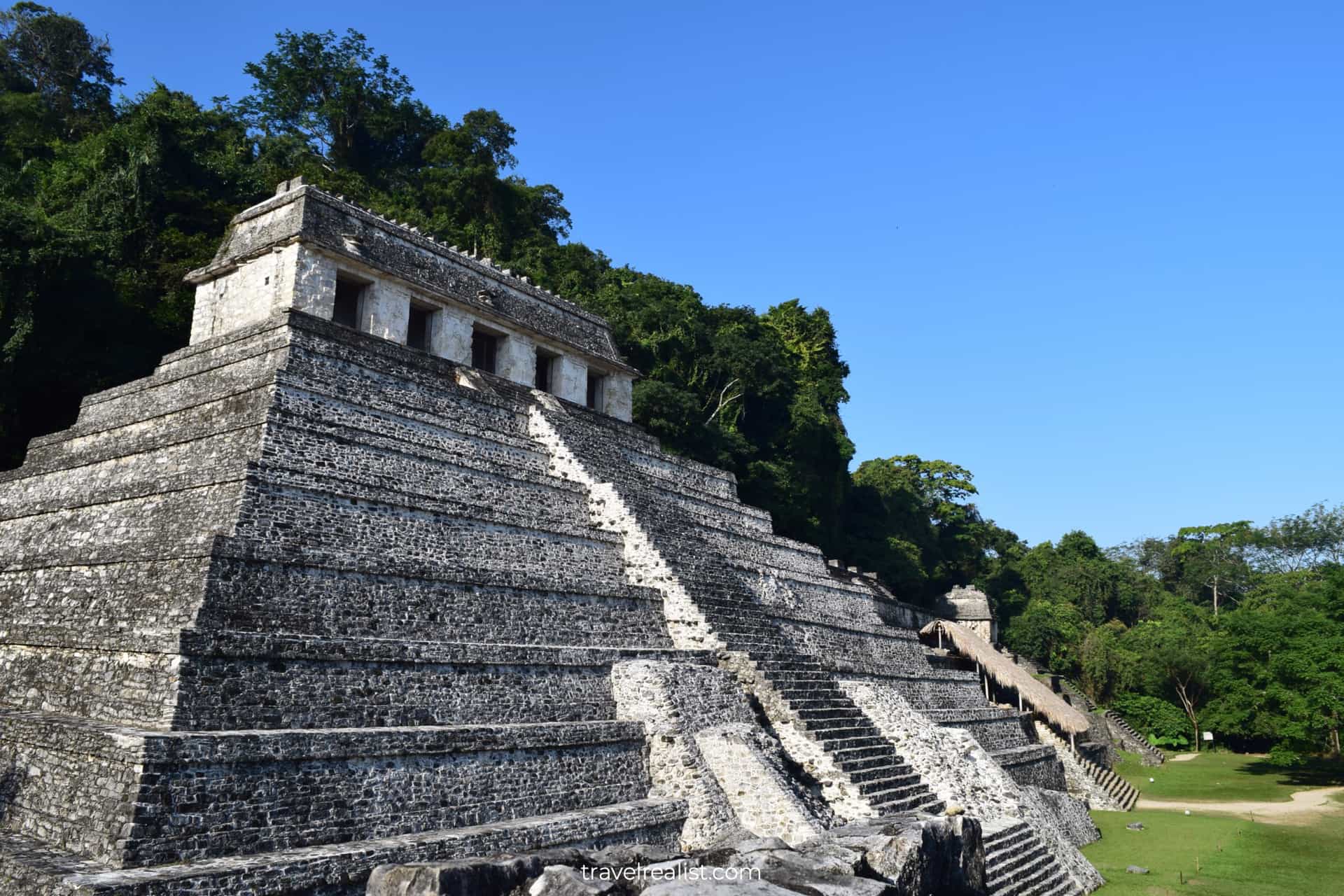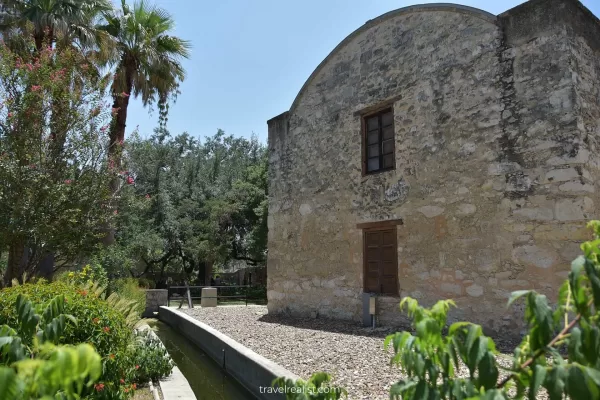Waterloo Village Historic Site: A Free Trip Back in Time
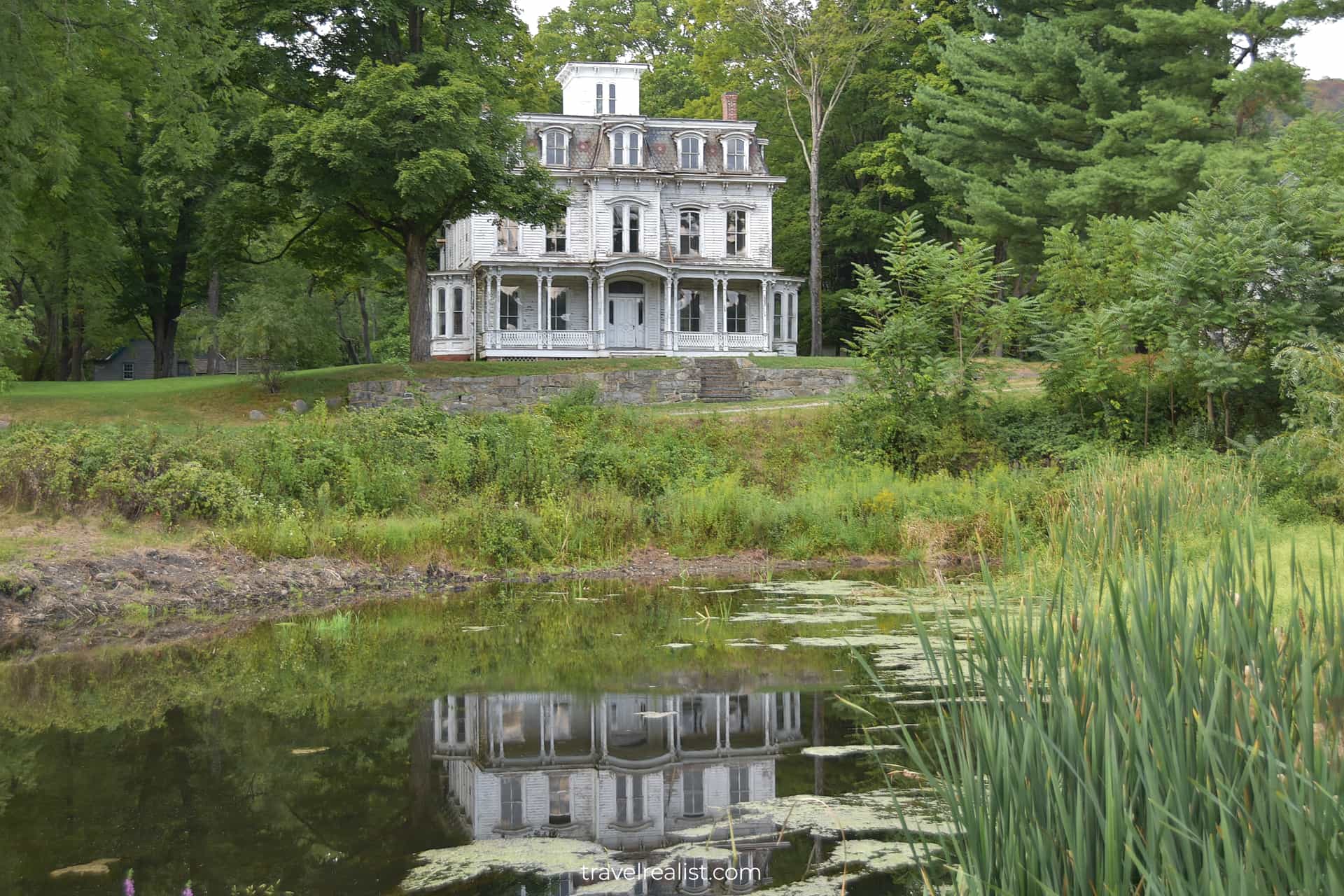
This realistic Waterloo Village Historic Site Guide helps you plan your next adventure in this park along the Morris Canal.
Waterloo Village Historic Site is a restored collection of historic buildings from the 18th and 19th centuries. The village is a great place for a walk next to a handful of house museums.
- Sights & Places of Interest
- 1. Morris Canal
- 2. United Methodist Church
- 3. Canal House
- 4. Seymour Smith House
- 5. John Smith Homestead
- 6. Smith’s General Store
- 7. Blacksmith Shop
- 8. Musconetcong River
- 9. Mule Bridge
- 10. Sawmill
- 11. Coal House & Gristmill
- 12. Hotel & Tavern
- 13. Peter Smith House
- 14. Ironmasters House
- 15. Canal Museum
- 16. Library
- 17. Waterloo Lake
- 18. Samuel Smith Carriage House
- 19. Peter Smith Carriage House
- 20. Jakes House
- 21. Visitor Center
- 22. Pavilion & Meeting House
- 23. Living Farm
- Getting to Waterloo Village Historic Site
- Where to Stay near Waterloo Village
- Entrance Requirements & Passes
- Takeaways: Waterloo Village Historic Site
This post includes affiliate links that will earn us commission if you make a purchase via these links.
Sights & Places of Interest
Waterloo Village has 22 historic buildings. Most of them are on Waterloo Village Road along the Morris Canal. A few other buildings, like most Coach Houses, make up the second row of structures.
The parking lot is on the western side of the village, opposite Waterloo Lake. You could take a loop walk around the site and explore all buildings in about an hour.
This Waterloo Village Historic Site Guide gives you all the information you need to visit this scenic park.
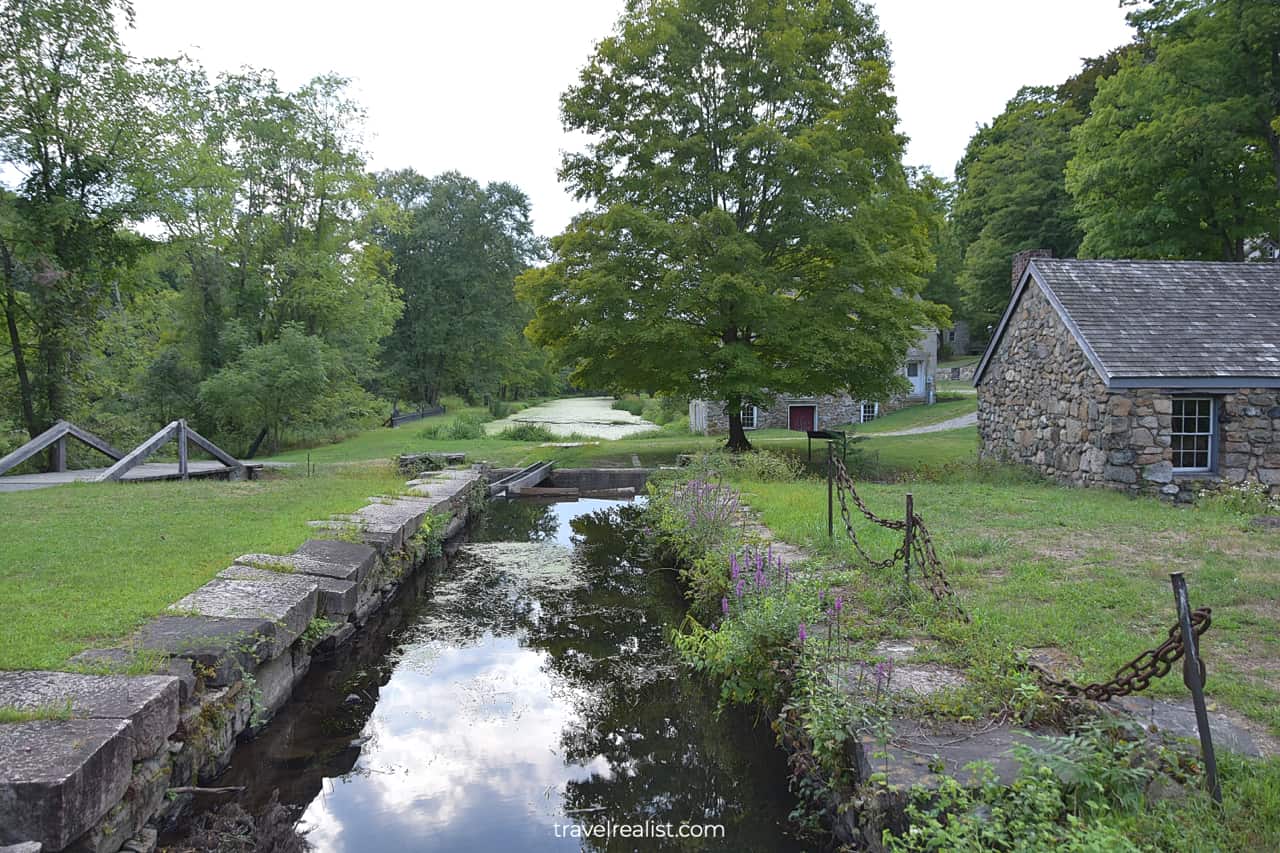
1. Morris Canal
You cannot talk about Waterloo Village without mentioning the Morris Canal. The village existed before the canal. But its creation brought more people and jobs to the area.
The Morris Canal was built from 1825 to 1832. It connects Easton, Pennsylvania with Newark, New Jersey. Its main purpose was to facilitate trade.
The canal has a total length of 107 miles (172 km). It also managed to accommodate an elevation change of 900 ft (274 m). There are 23 locks that made it happen.
The Morris Canal was an important route for nearly 100 years. As internal combustion engine powered cars took over transportation, the canal went to decay in 1929.
The canal closure also had some unintended consequences. Towns along its route became less relevant. The Great Depression did not help. As a result, Waterloo Village was abandoned in the 1930s.
The State of New Jersey and volunteers restored a few buildings in this village. This process continues to this day. You could even donate your time or money to bring the history back to life.
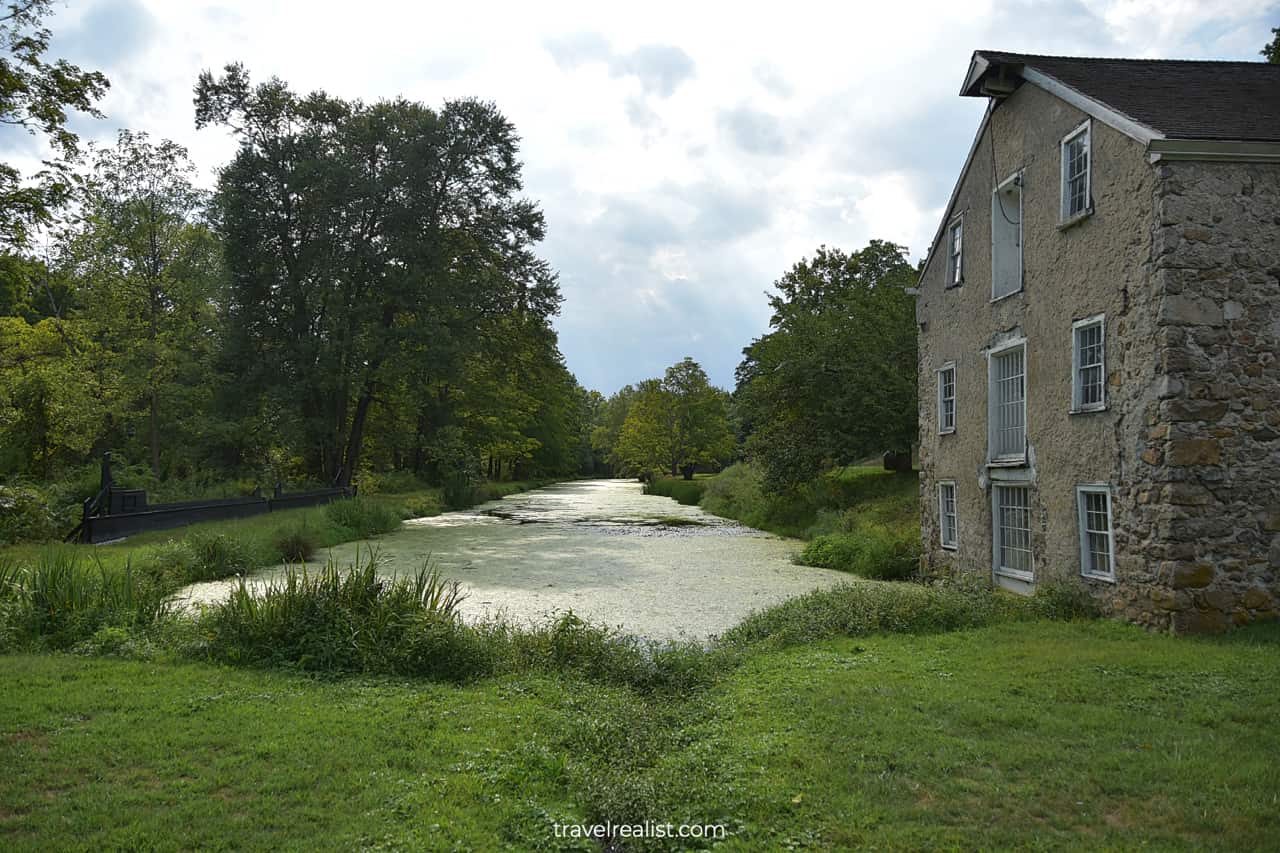
2. United Methodist Church
The Waterloo United Methodist Church is the closest building to the parking lot in the village. The church dates back to 1850s.
It is still in use today. As a result, the church is one of the buildings in Waterloo Village that you could enter. You could use this opportunity to see the historic interior of this church.
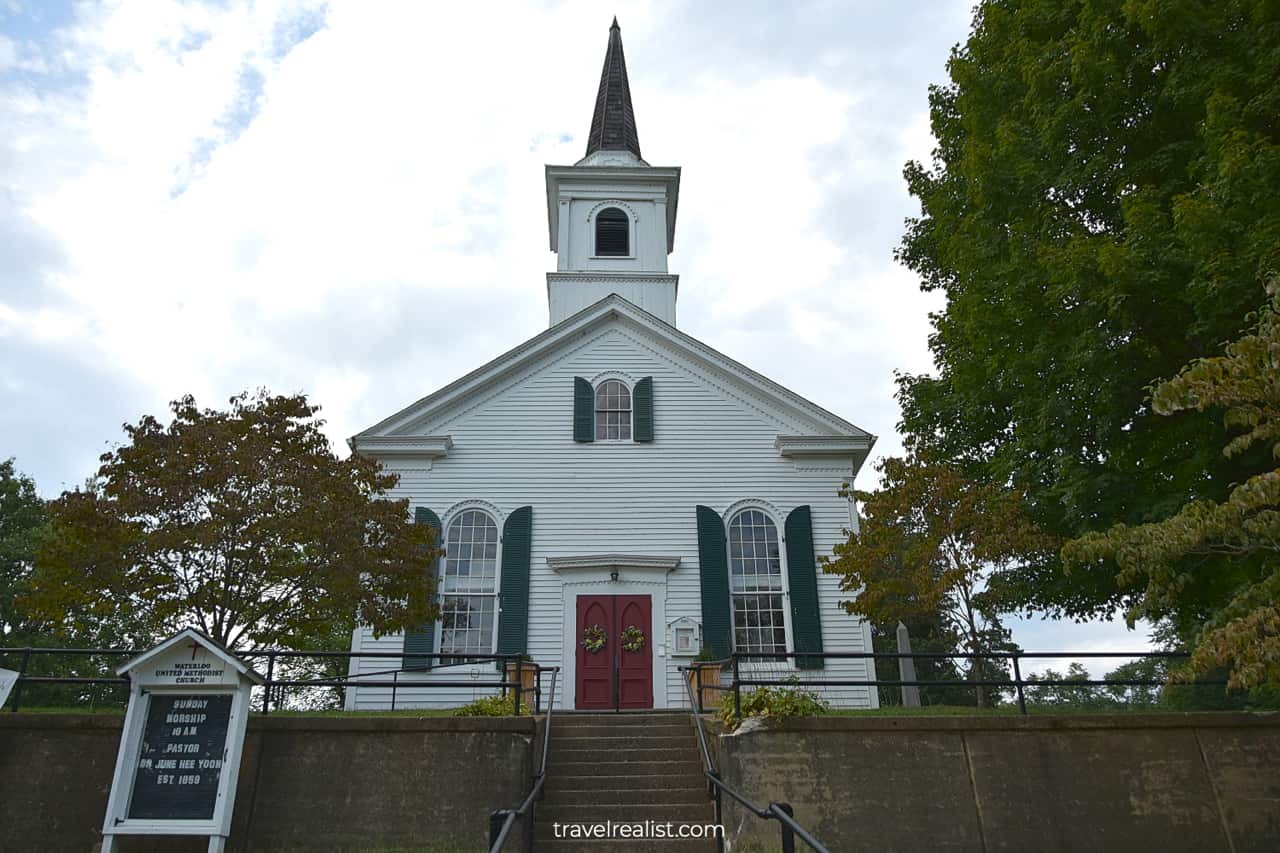
3. Canal House
The Canal or Tenant House is one of the first residential buildings of Waterloo Village. This building dates back to 1840s, a few years after the completion of the Morris Canal.
The Canal House was the only apartment building in the village. It provided space for two families. There was an inner shared inner wall between them.
The mirror windows of the Canal House look just like the Letter Box in Grey Towers. This house is also open to public from time to time. A 180-year old townhouse is also a sight to see.
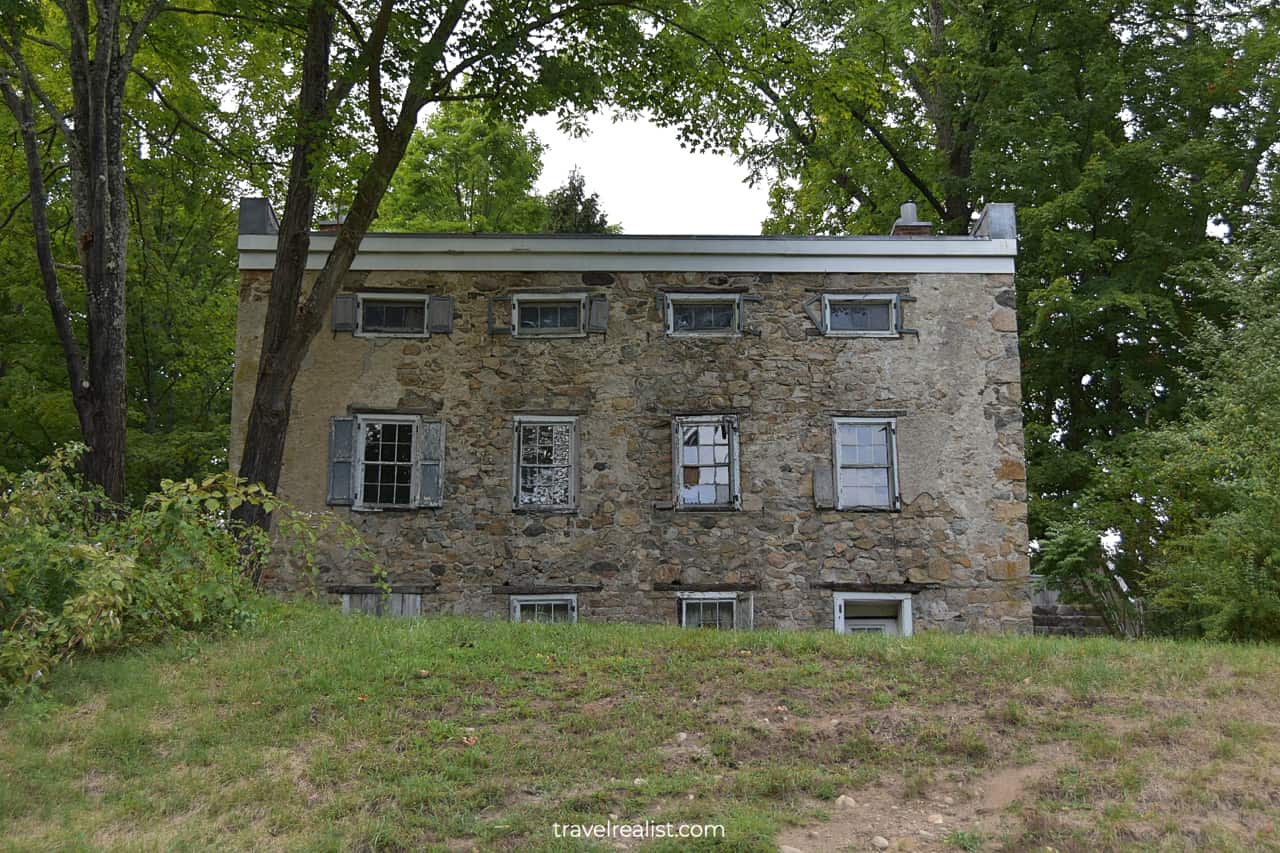
4. Seymour Smith House
You will see a beautiful wooden house next. This is the Seymour Smith House. The mansion dates back to 1876. It comes from an era when lavish Victorian mansions were built across the country.
The Meeker Mansion in Washington and Haas-Lilienthal House in California are other homes from the same time. Just like the more famous mansions, you could tour this house every now and then.
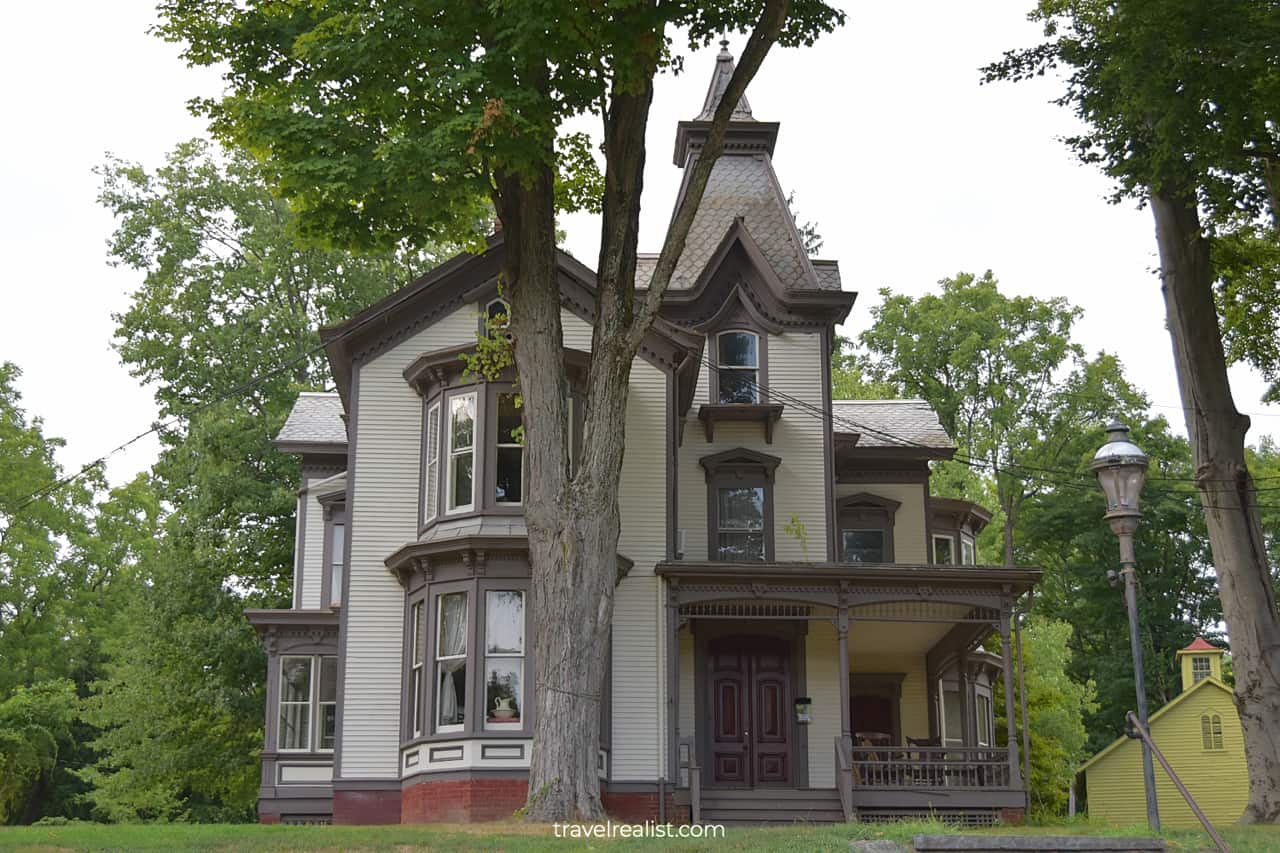
5. John Smith Homestead
You might not think much of the next house in Waterloo Village. It certainly pales in comparison to the nearby Seymour Smith House.
But it is one of the oldest buildings in the area. The John Smith Homestead, or just the Homestead, dates back to 1760s.
The Homestead Carriage House is known as the “Green Barn”. It is slightly behind the Homestead. The “Green Barn” is over 100 years old younger than the house.
The Homestead is a stone house. This setup might have helped it survive for over 250 years. This building is off limits to public year round. You could admire it only from the outside.
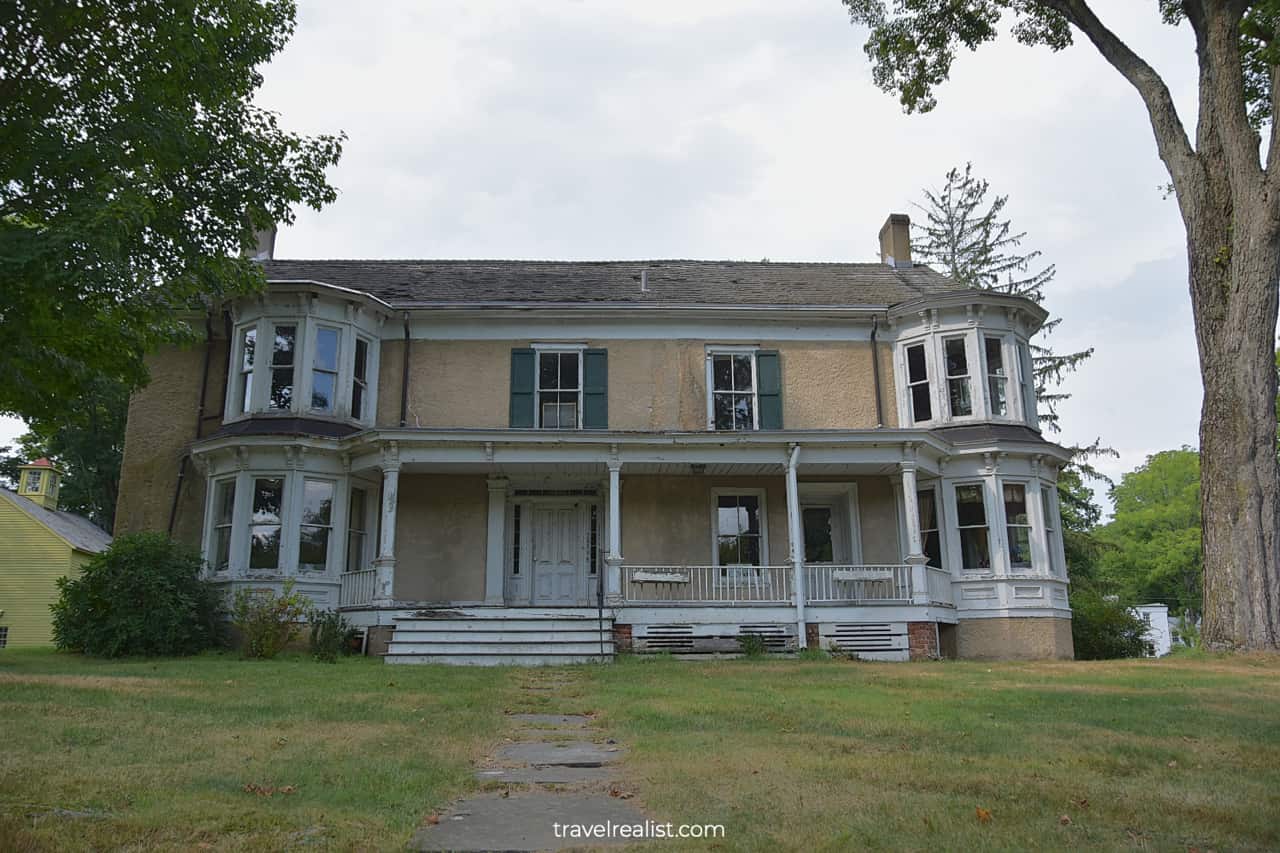
6. Smith’s General Store
You will see a lone standing building on the other side of Waterloo Valley Road. It is the Smith’s General Store. The building dates back to the 1830s. It was built after the Morris Canal was completed.
So, the placement of this building was not an accident. It allowed for the store owners and staff to restock supplies using canal boats. These boats would have ample space to dock behind the store.
The store is sometimes opened to public. You could see common trade goods and exhibits inside, just like at the French Castle in Fort Niagara State Park.
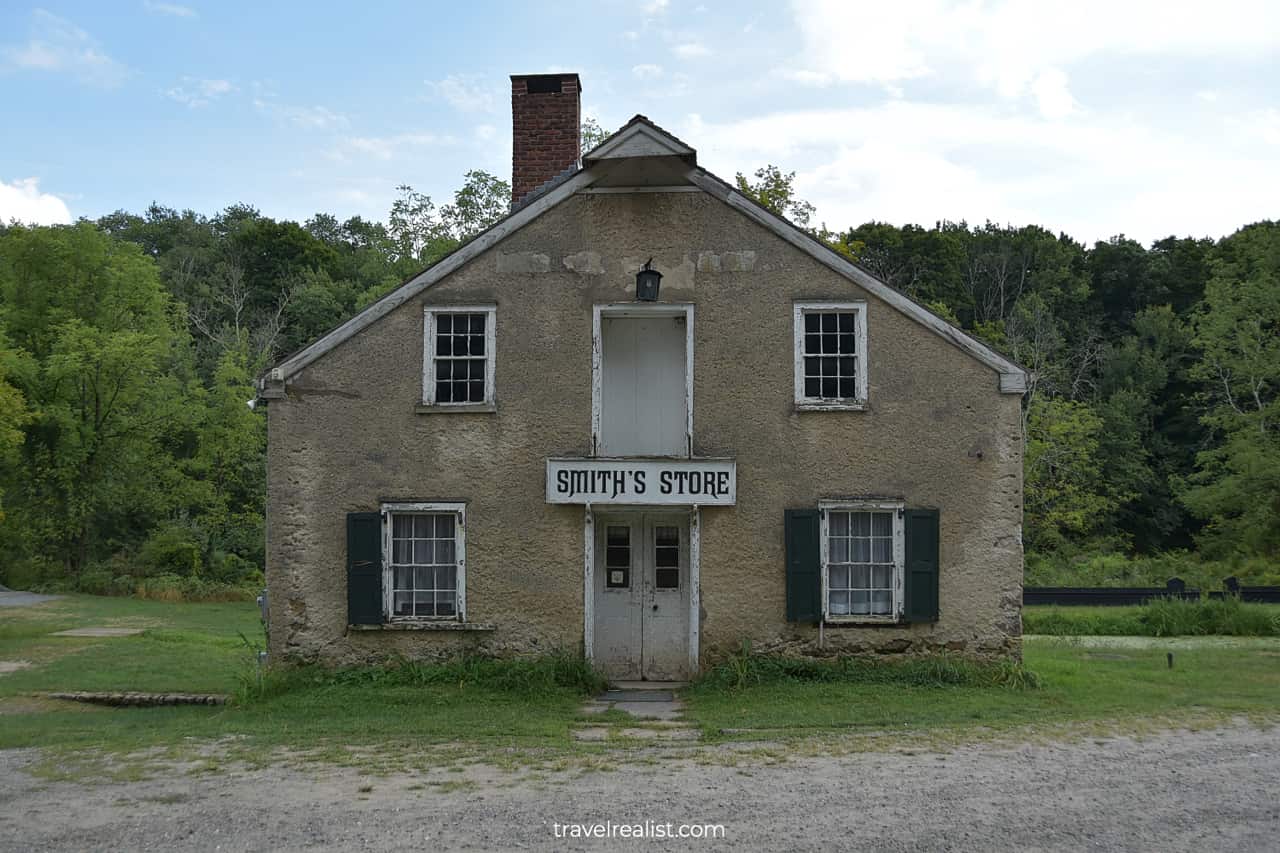
7. Blacksmith Shop
A canal lock is on full display next to the Smith’s General Store and the Blacksmith Shop. The lock is a true engineering masterpiece. This human made structure looks like a waterfall now.
The Blacksmith Shop is a smaller stone building of the two. John Smith built the original Blacksmith Shop around 1780. But even more work for the blacksmiths came with the creation of the Morris Canal.
Canal mules were the main the source of transport in the area back in the day. As a result, forging muleshoes was one of the key activity for the blacksmiths.
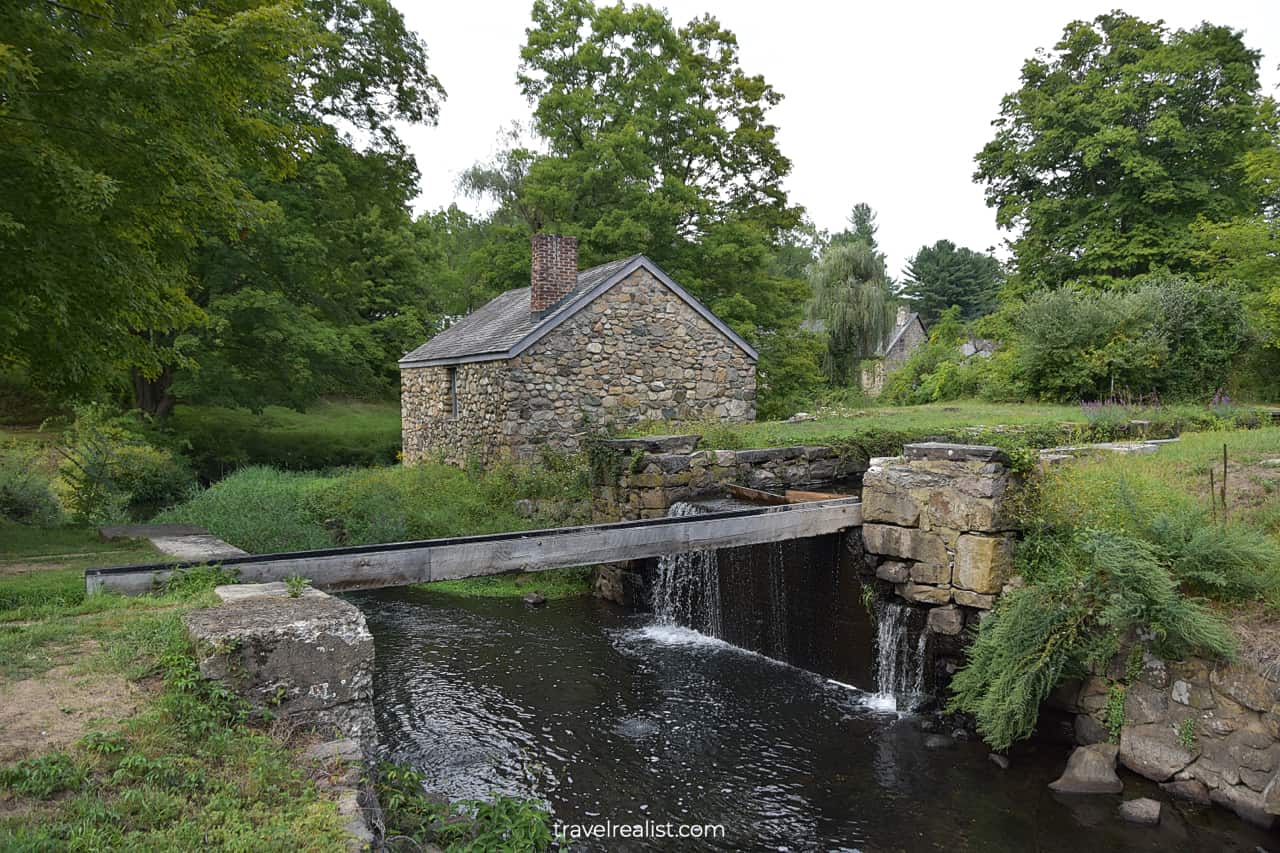
The Blacksmith Shop and the Canal Lock are a known wildlife spot. You have a good chance of seeing a groundhog if you visit this area in the summer.
You might be able to see this animal right next to the Canal Lock. Remember to keep wildlife wild and maintain a safe distance. This way, you could make this experience safe for both parties.

8. Musconetcong River
You will come to the banks of the Musconetcong River as soon as you pass the Blacksmith Shop. This section of the river has two dams.
One of them is near the Lock and Blacksmith Shop. The other is further upstream at Waterloo Lake. As a result, the river has a slow current in this section. It is perfect for capturing forest reflections.
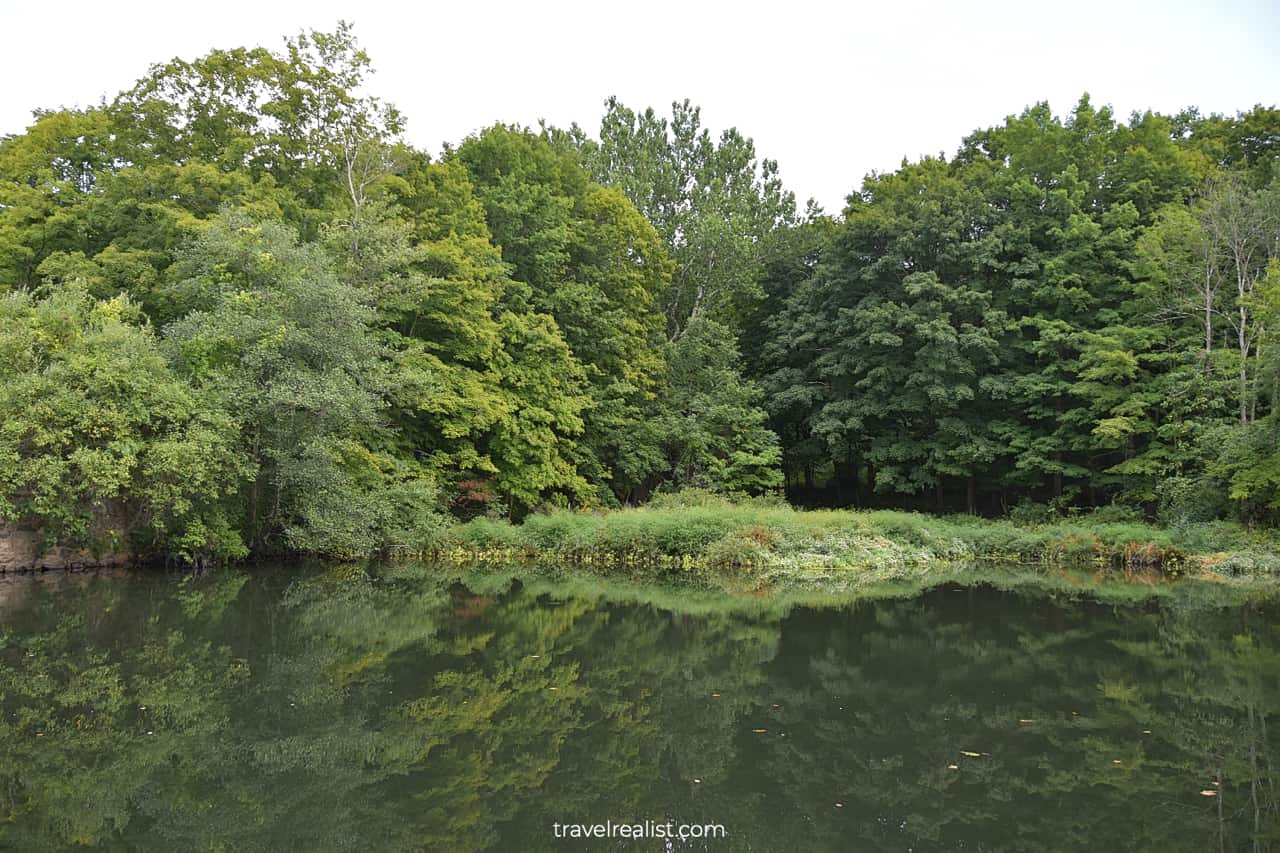
The river banks are full of purple loosestrife or lythrum. This invasive plant has picturesque purple flowers if you visit Waterloo Village in the summer.
It is a highly invasive perennial flower that likes wetlands. It could be covering the entire north bank of the river when you make it to this park.

9. Mule Bridge
The Mule Bridge used to connect the banks of the river. But this wooden bridge is in a dire condition. Three out of its five sections are almost completely gone.
The central section is tilted and partially underwater. Most other bridge sections are missing boards. There are exposed nails and sharp edges.
As a result, the bridge is not safe to use. But it makes for a surprinsingly scenic centerpiece on a photo. This bridge shows the inevitable decay of things without maintenance.
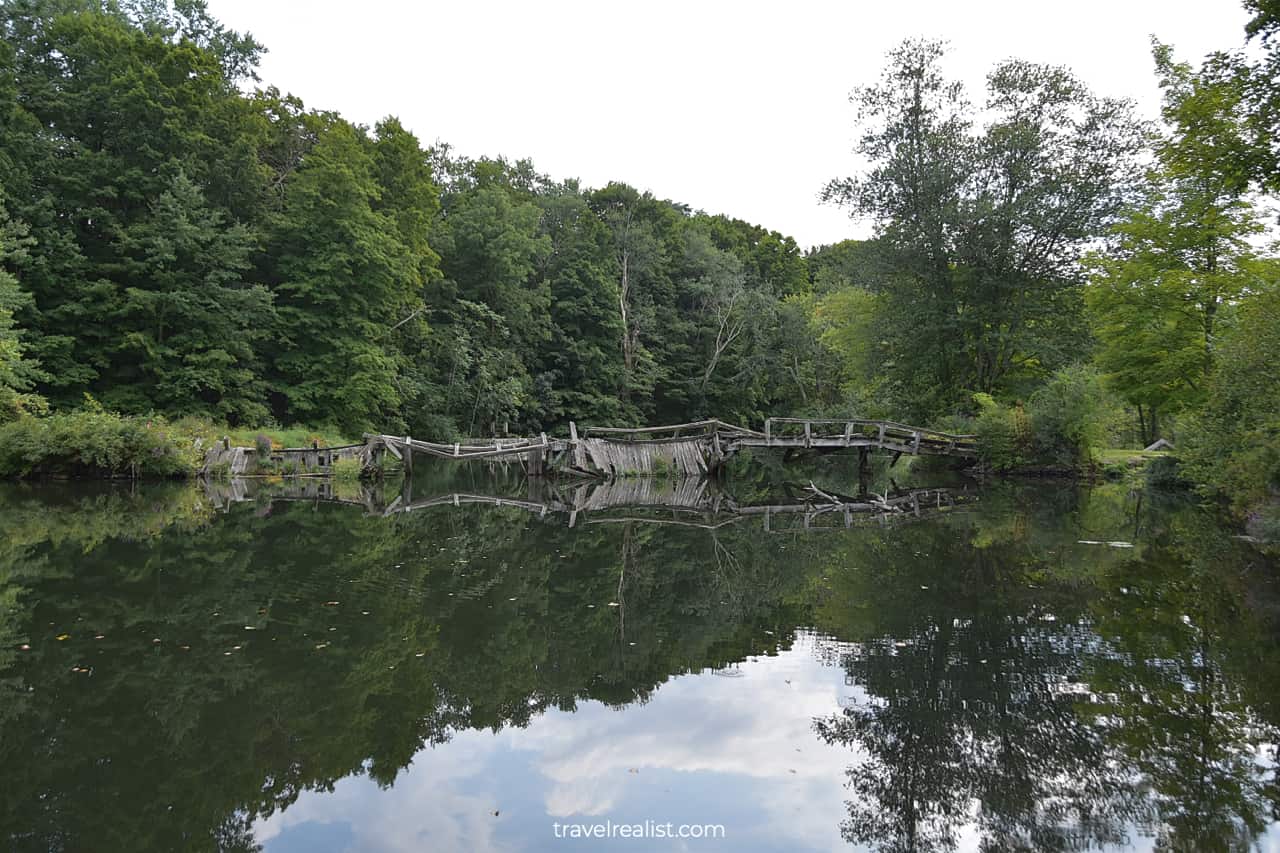
10. Sawmill
Once you have explored the banks of the river, you could head back towards the village. The Sawmill is the closest structure to the river.
It is also another building you could explore from the inside. Head into this wooden structure through the wide open doors.
You will see the sawmill machinery inside. Back in the day, the sawmill used the power of water to cut lumber. It is a great live exhibit about life some 200 years ago.
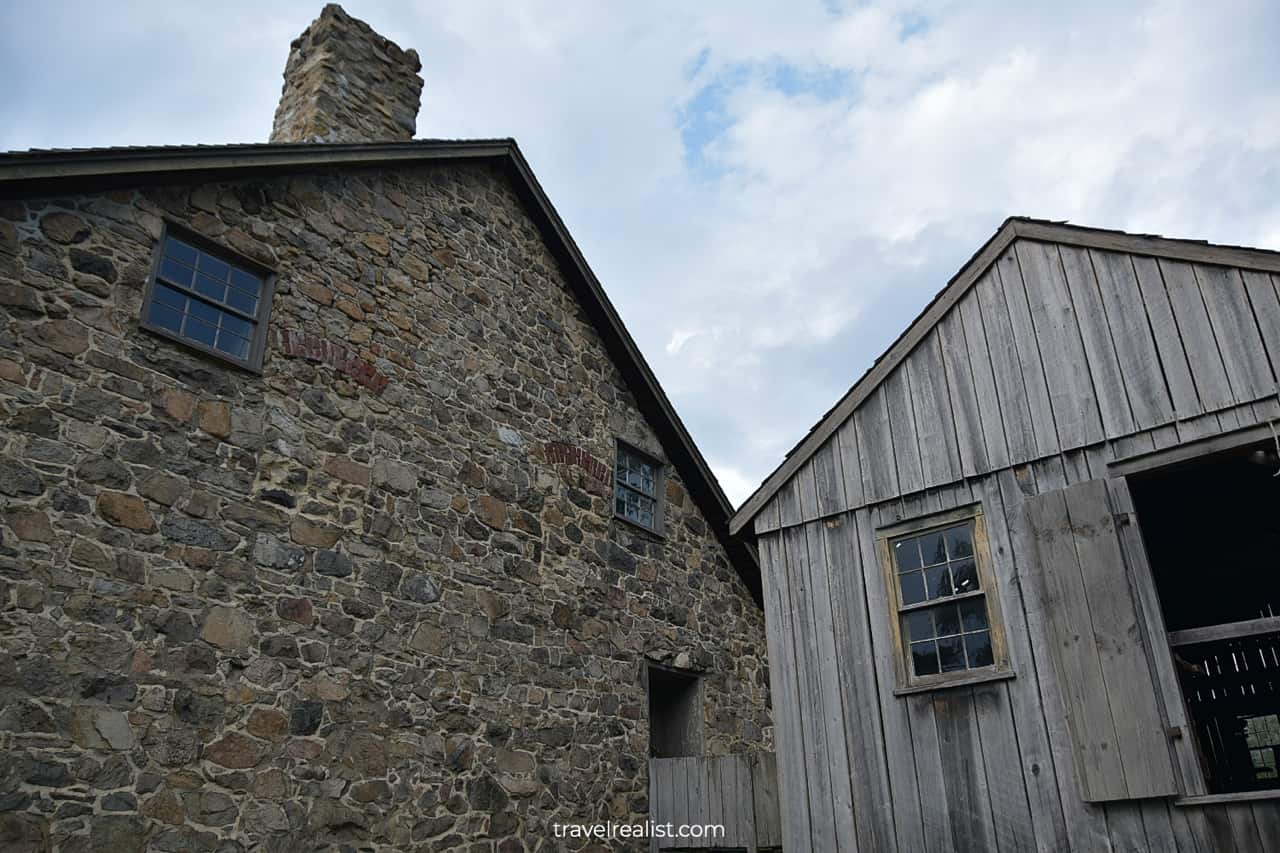
There are also a handful of tools inside but hardly any other exhibits. You might have to guess the names and use cases for some of them. A Google Lens app might help in this endeavor.
The Sawmill creates an industrial area together with the nearby Coal House and Gristmill. The Morris Canal has minimal flow. It makes another great spot for capturing water reflections.
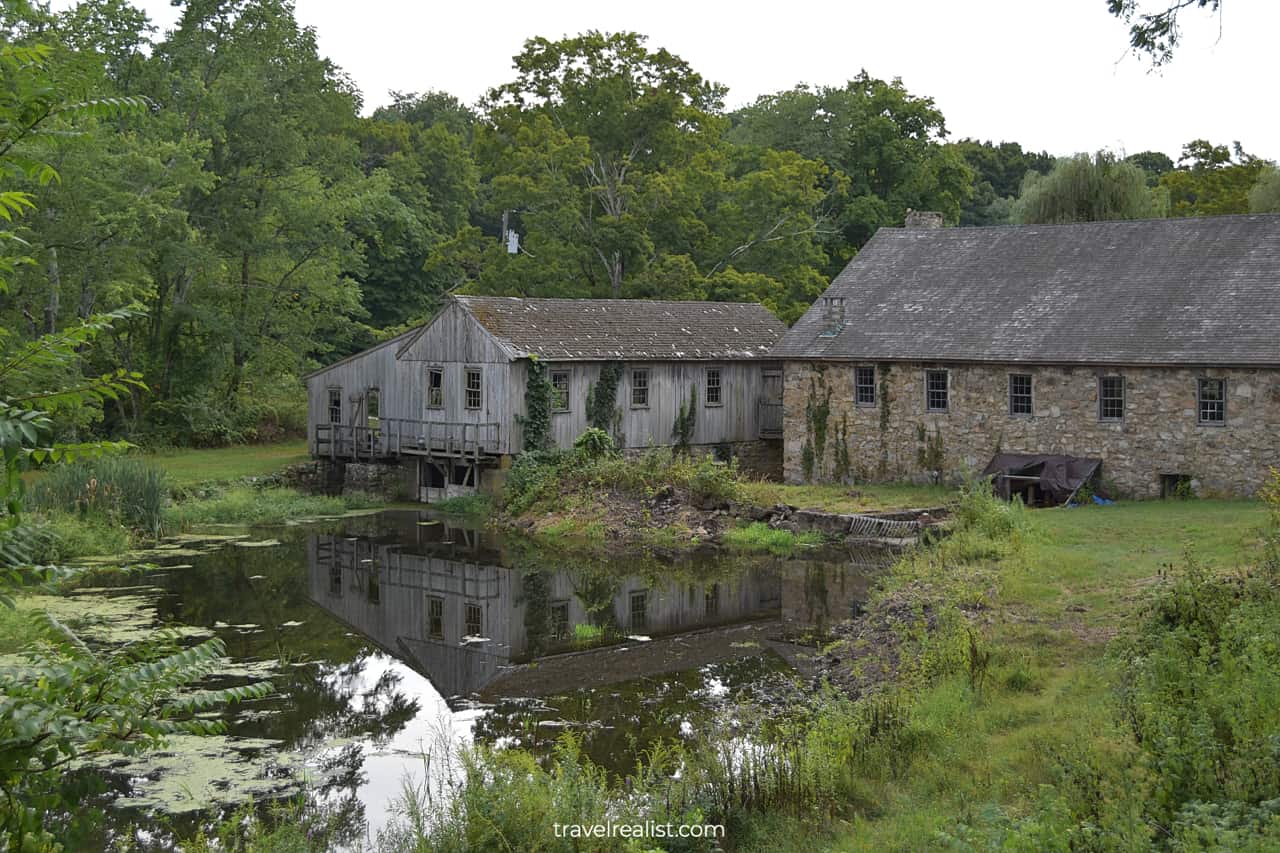
You could see the reflections of the Sawmill, Gristmill, and Coal House in the canal. But it goes both ways. You will see a beautiful white house if you look north while standing next to the Sawmill.
The Peter D. Smith House will be reflecting in the canal. Countless cattails and algae add a flair of mystery to this place. It looks a bit like the houses from the horror movies.
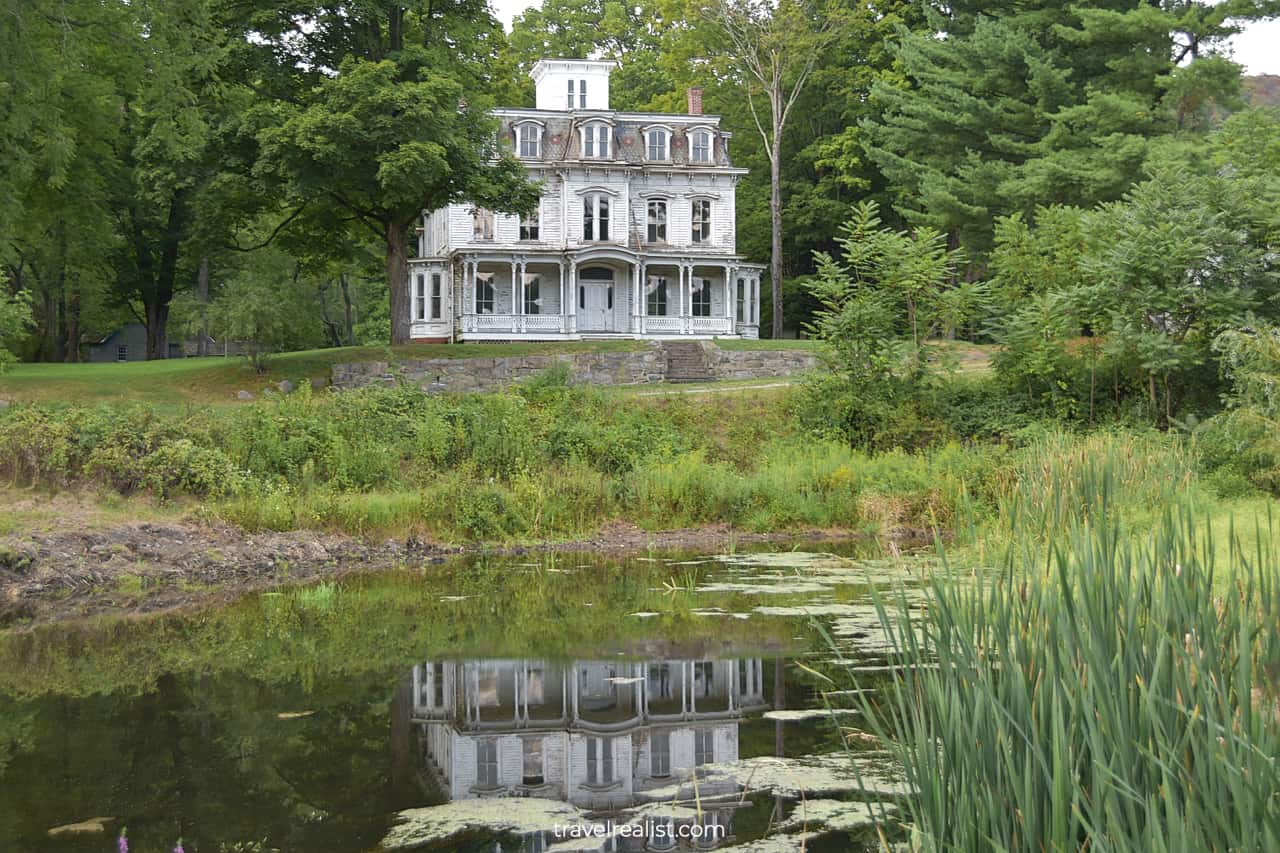
11. Coal House & Gristmill
You will be exploring the Peter Smith House in just a few minutes. But you should check out the Coal House and Gristmill first. This building is a massive stone structure.
You cannot go inside of the Gristmill. Of course, you could try to see something via its small windows. But you might not see much other than a few older stone and metal mill wheels outside.
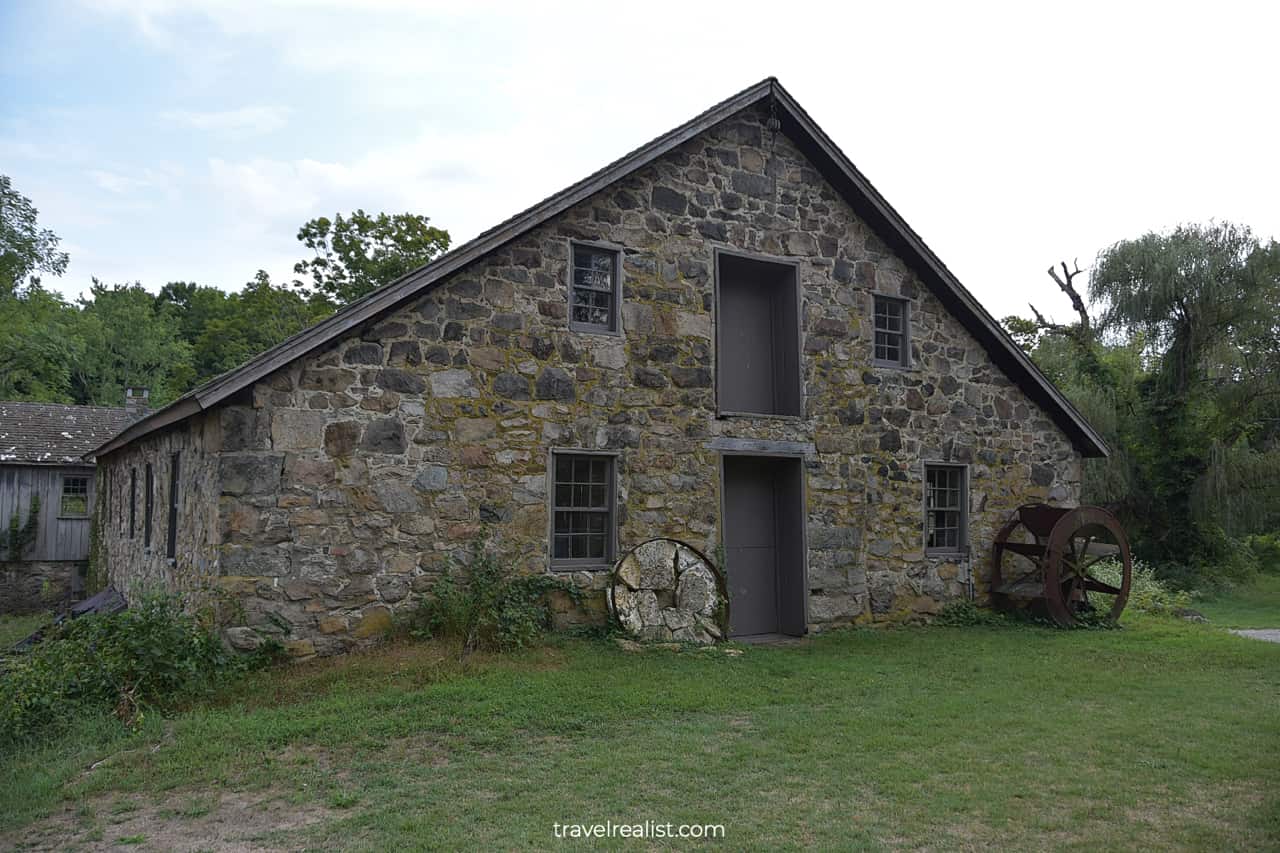
12. Hotel & Tavern
As you make your way back from the mills, you will see a house on a hill. This is one of the oldest structures in Waterloo Village. It dates back to the 1760s.
This building was a tavern and a hotel. It must have been necessary during the times when the John Smith Homestead was the only home in the area.
The inside of the Hotel and Tavern is sometimes open for you to explore. Do not miss a chance to see the interior of the 250+ year old house.
You would have to go to Cambridge, Massachusetts to see the Longfellow House otherwise. It is one of the few houses of that era open to public.
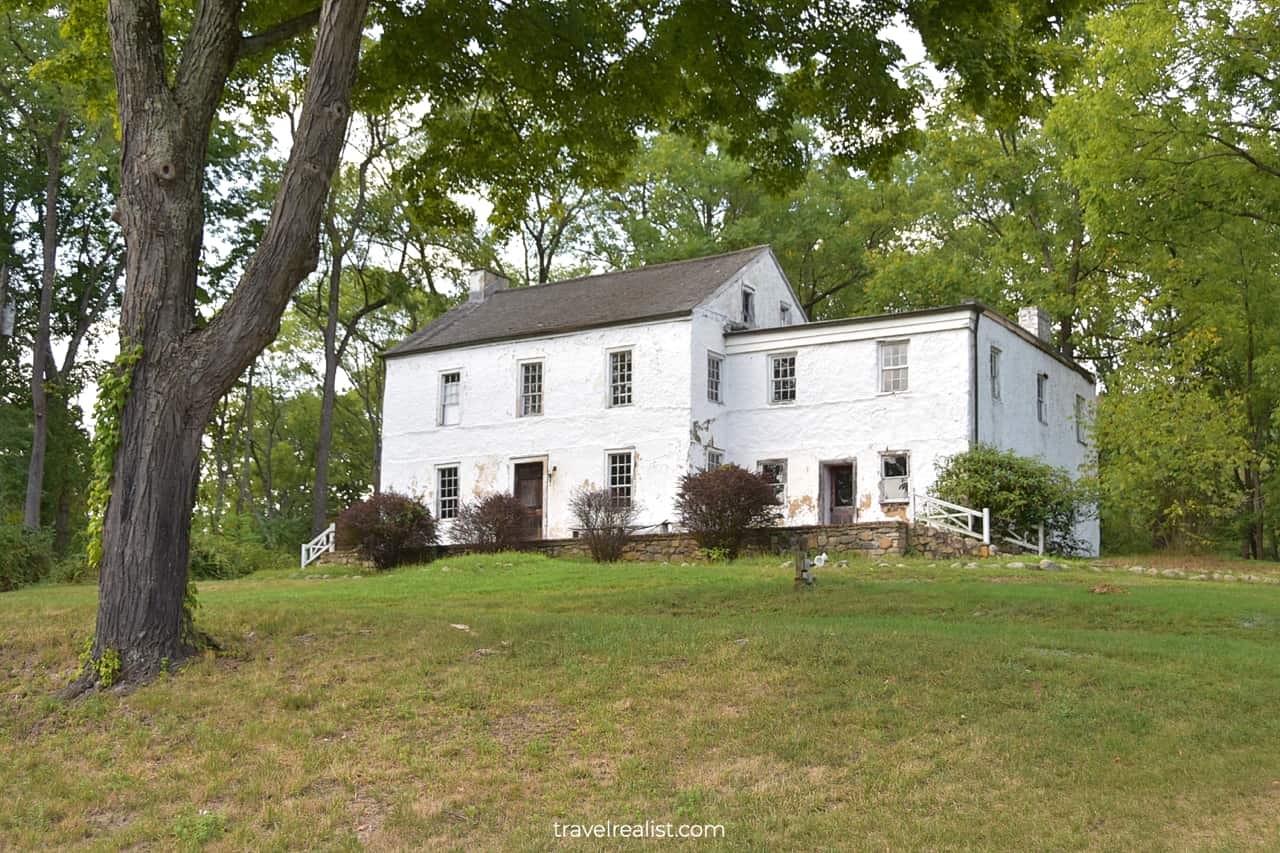
13. Peter Smith House
At last, you will arrive at the Peter Smith House. This building is one of the most beautiful houses in Waterloo Village.
It dates back to the 1870s. Time has shown its scars on the exterior of the building. Timber and roof have a few signs of age. But the staff at Waterloo Village has done a great job preserving this building.
This house is in a very fragile state. You cannot visit the Peter Smith House. Take your time as you admire it from the outside. Its thoughtful design could rival a handful of the more famous house museums.
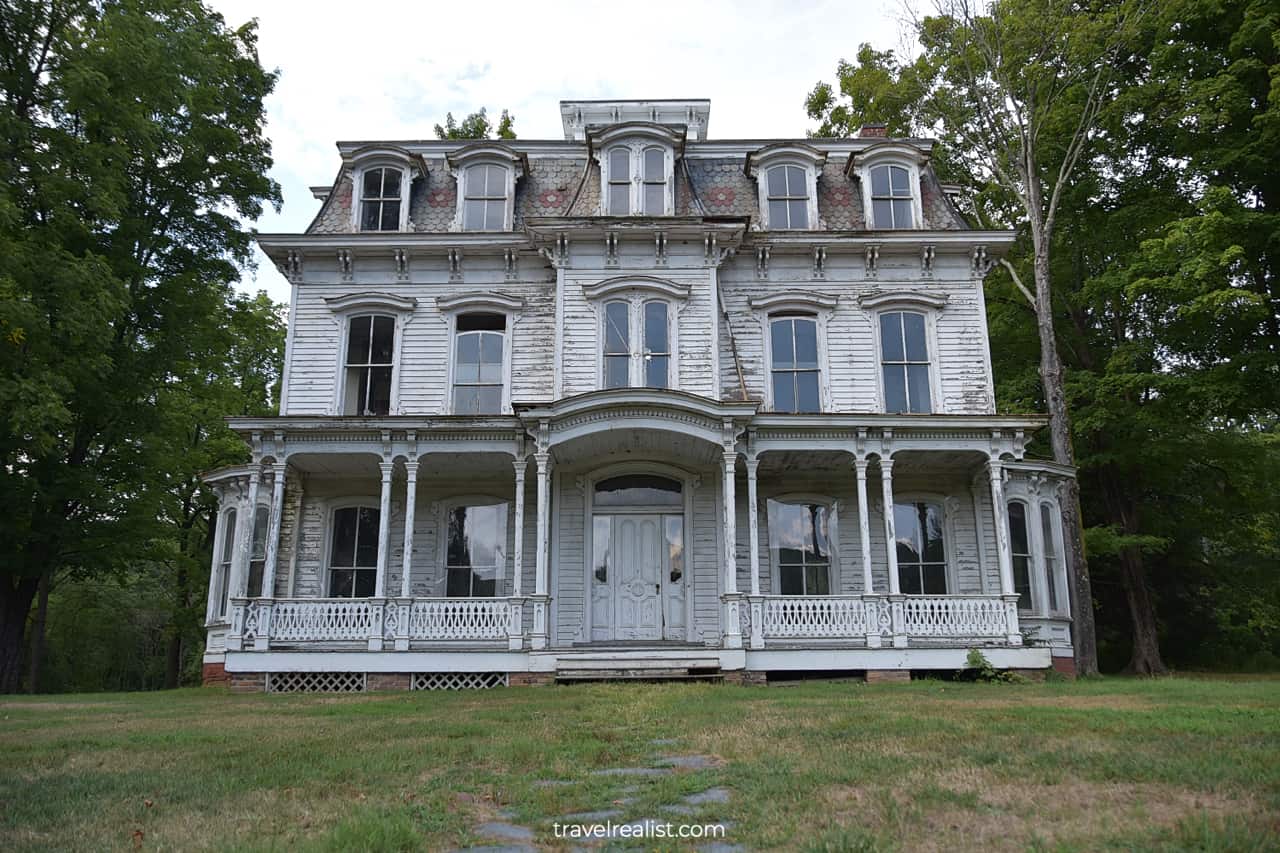
14. Ironmasters House
The condition of the Ironmasters House leaves much to be desired. This building is close to falling apart. Its roof and exterior are in need of restoration.
This house gives you an idea of how most buildings in the village looked like about 50 years ago. There is a fence around this house. It protects the visitors from exposed nails and boards.
You might want to contribute to saving this historic park. You could volunteer, donate directly, or join an event at Waterloo Village.
These events usually have a small admission fee. This way, you could put your dollars towards preserving Waterloo Village.
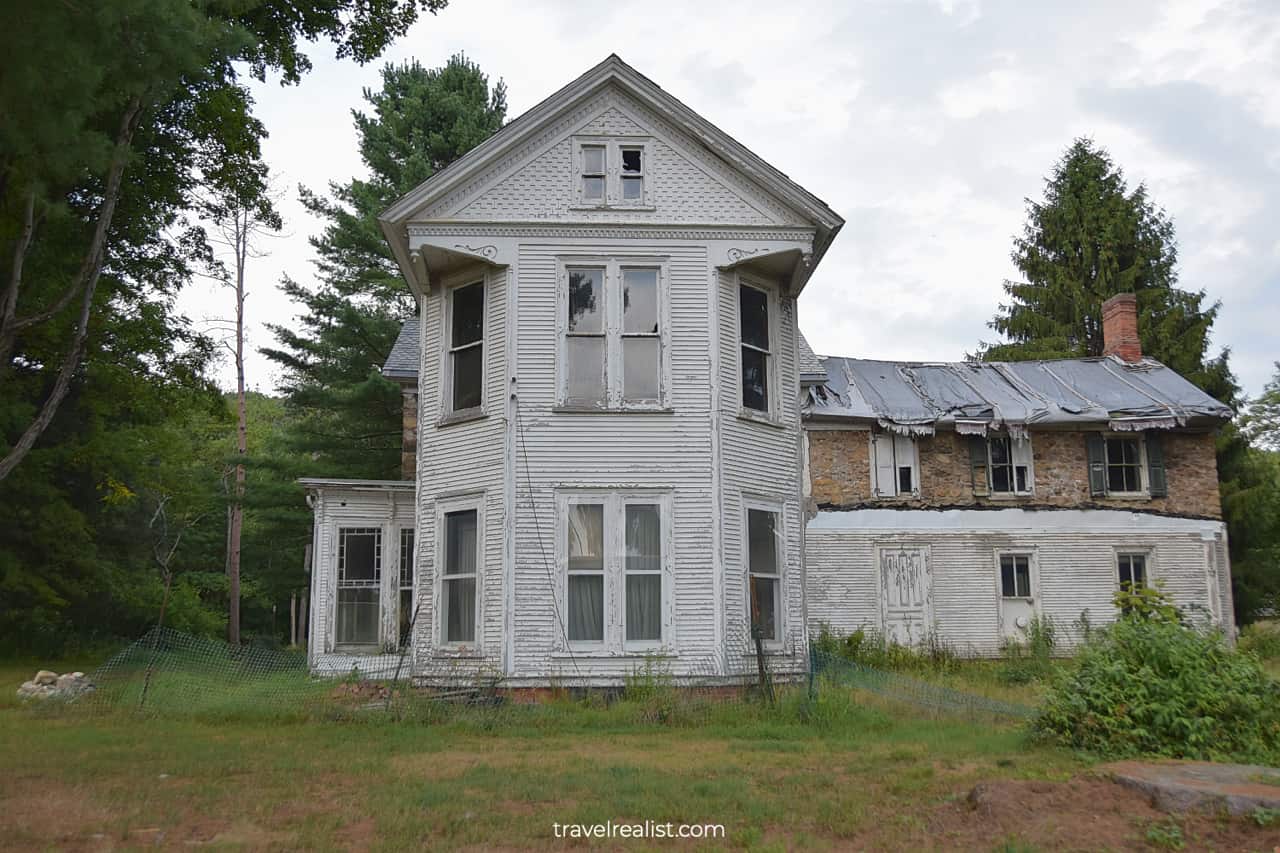
15. Canal Museum
The next building in Waterloo Village gives you a schedule to explore its interior. The Canal Museum is open from 10 a.m. to 4 p.m. on Saturdays in the summer.
The exhibits inside tell a story of the Morris Canal. You could see a few historic pieces in this small museum. Volunteers would be also happy to answer your burning questions about this park.
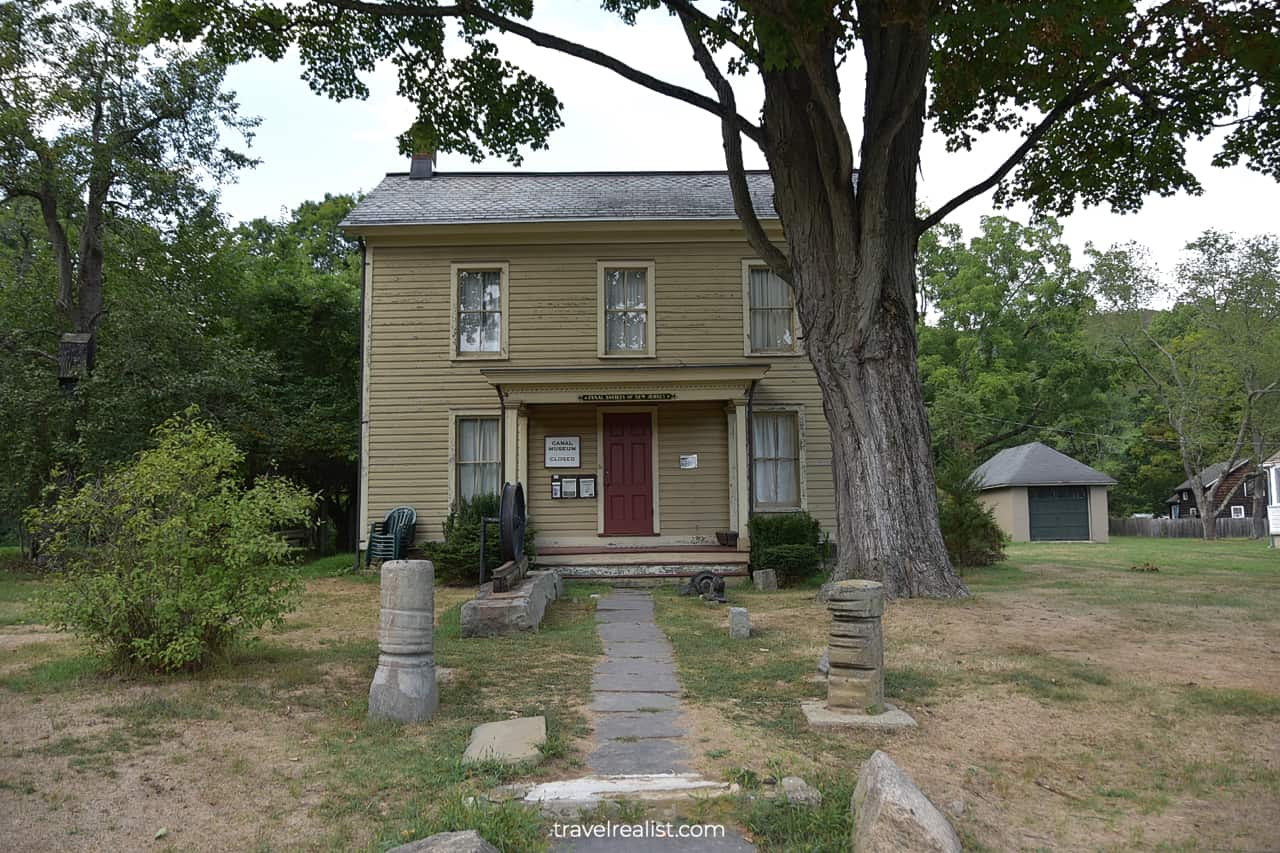
16. Library
The Library is a building next to the Canal Museum. Both houses date to the 1860s. They even share a similar design and decoration pattern.
Despite its name and purpose, this Library is closed to public. You could only walk around this building. But you will not see much apart from a screened patio.
The Library looks like a great number of houses in New Jersey. You do not need to go to a park to get similar views. All you need to do is head outside in the neighborhoods with the older houses.
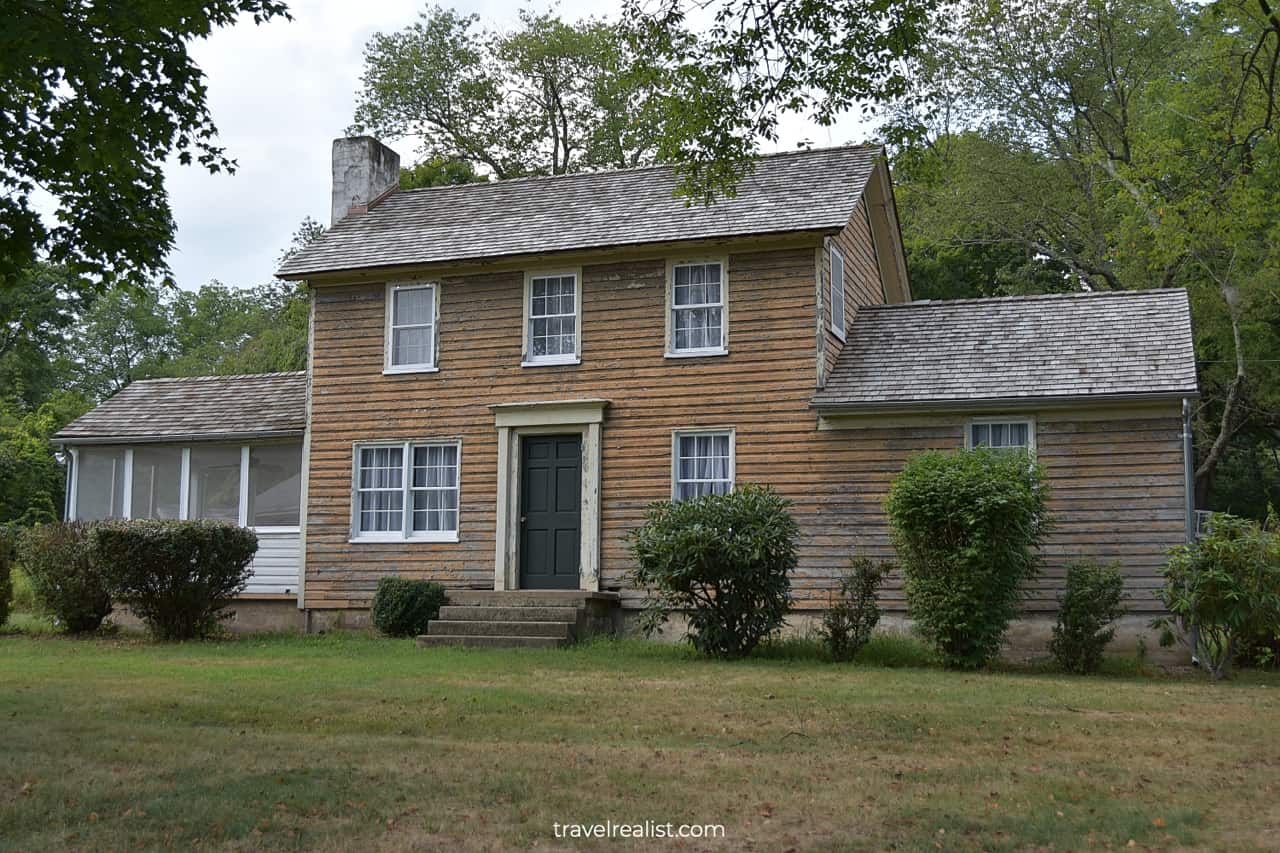
17. Waterloo Lake
You will reach Waterloo Lake just after you pass the Library and a Maintenance Building. This is a human made lake. It came to life when the Morris Canal was created.
The lake covers an area that is almost as large as the village. But you might not see it that way from Waterloo Valley Road. The islands and wetlands make it look like a winding river.
You might be able to explore the lake and the river upstream on a kayak. The park sometimes rents them during the summer. You should check at the Visitor Center if a rental is offered during your visit.
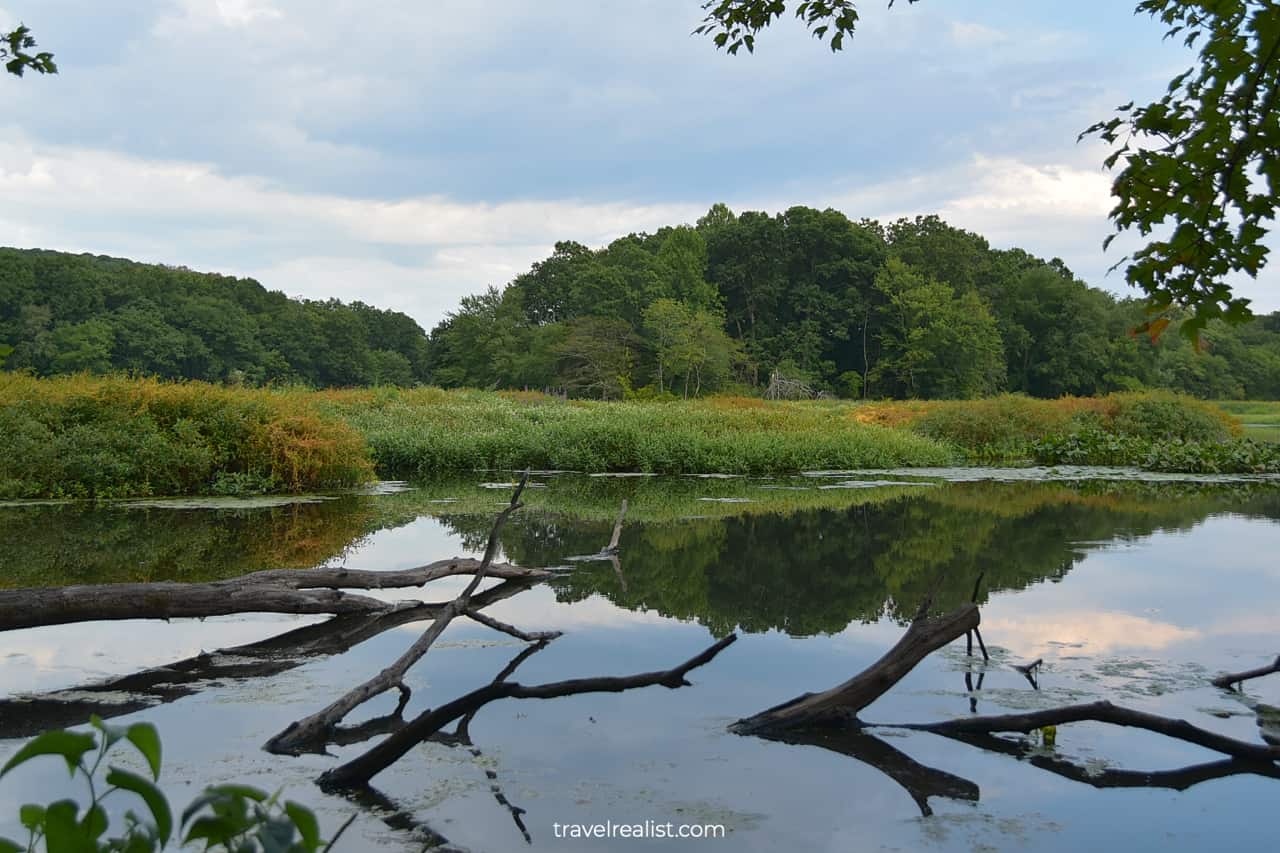
18. Samuel Smith Carriage House
You would have seen most of the houses in Waterloo Village by the time you reach Waterloo Lake. Still, there are a few more buildings for you to explore.
Take a path that goes behind the Library and the Museum. It runs parallel to Waterloo Valley Road. You will see the backyards of the homes and a few carriage houses.
These garage predecessors are also quite scenic in Waterloo Village. Take the Samuel Smith Carriage House. It has a beautiful exterior with a thoughtful design.
You might also hear the park staff refer to it as a “White Barn”. Whenever the building is open to public, you could see a Canal Boat exhibit inside.
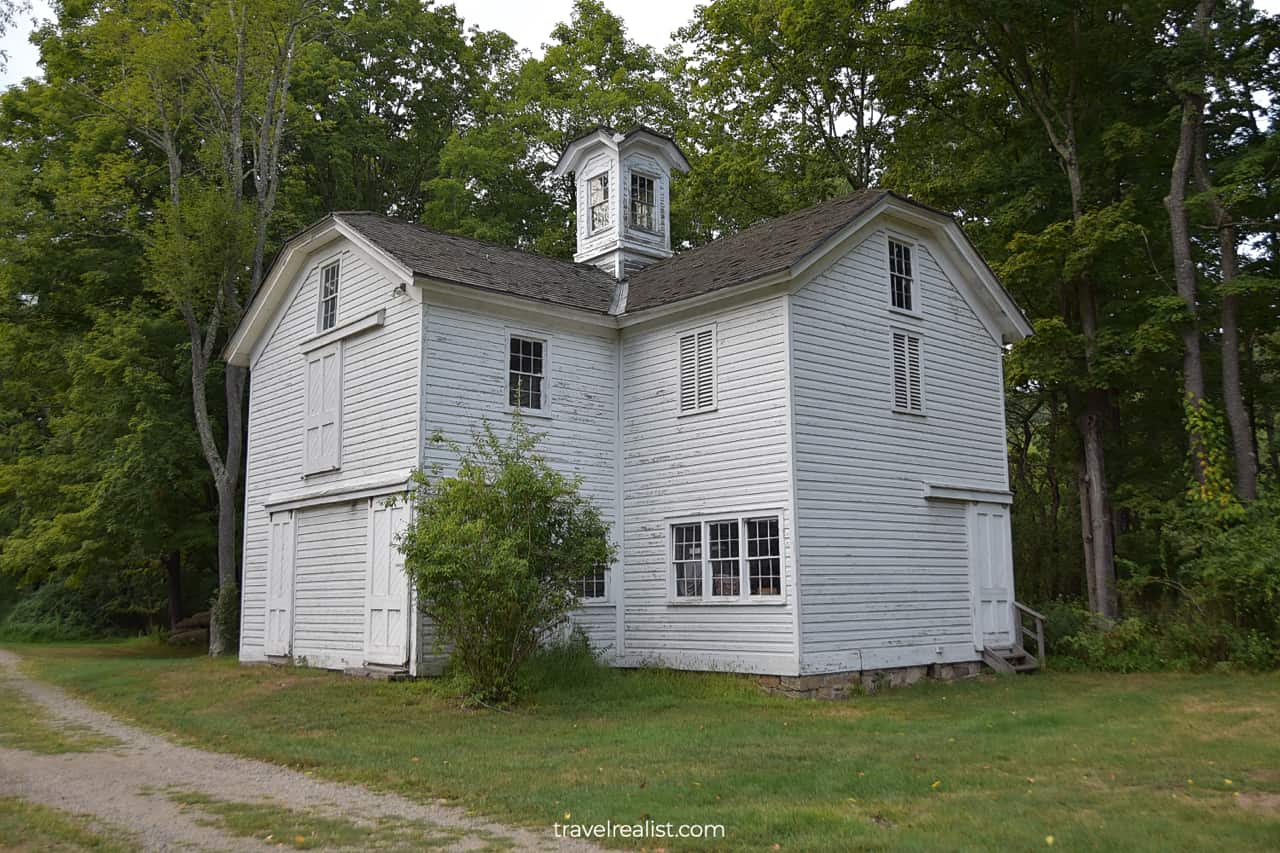
19. Peter Smith Carriage House
As you continue your walk towards the Visitor Center, you will see the second Carriage House. The Peter Smith Carriage House also carries a nickname of a “Blue Barn”.
It is another gorgeous building. It could rival many homesteads in beauty. A forged weather cane atop of the building tower adds to its appeal.
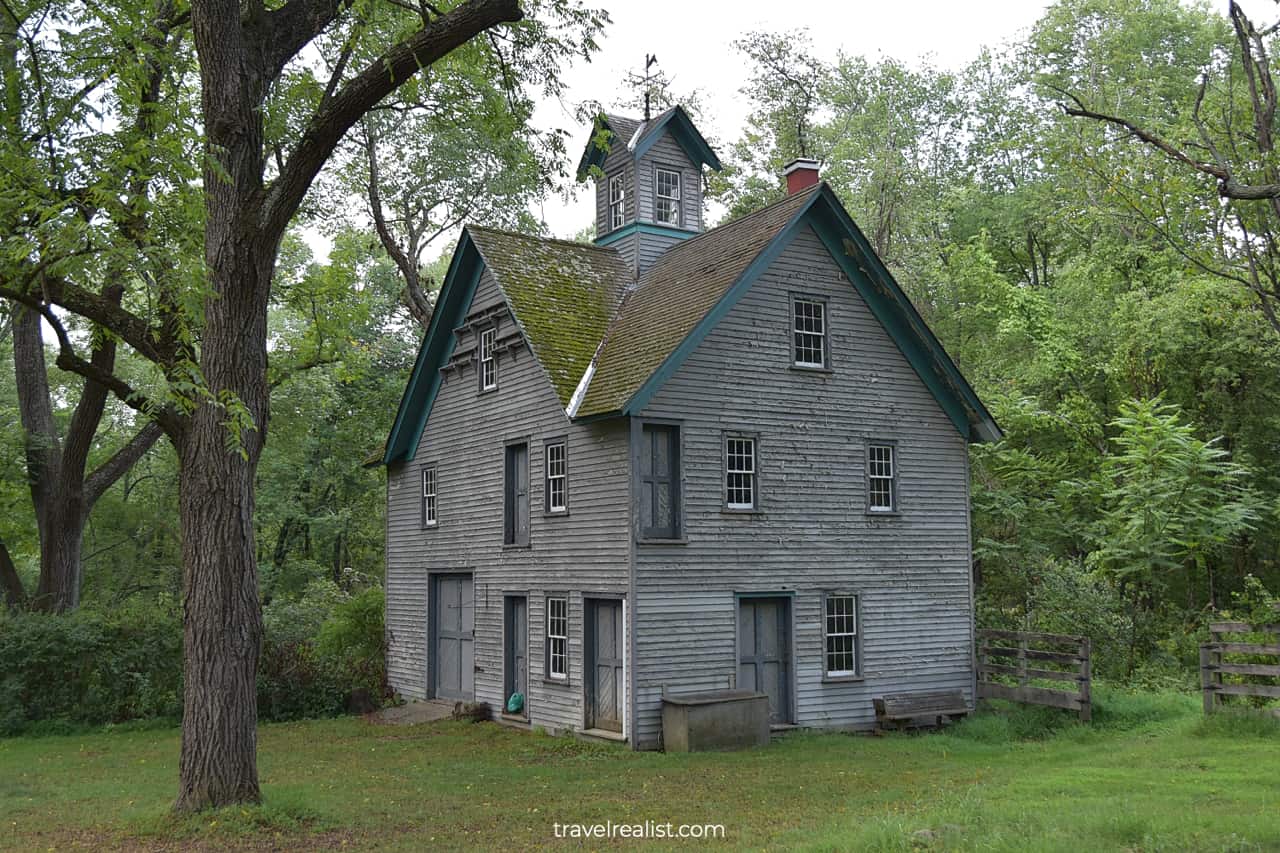
20. Jakes House
The “Blue Barn” is across the path from the the Jakes House. This is one of the youngest buildings in Waterloo Village. The Jakes House dates back to the 1980s.
The building belonged to a local character. It is a seamstress shop. There are a few exhibits inside. But unless you are on a school trip you are unlikely to ever explore it.
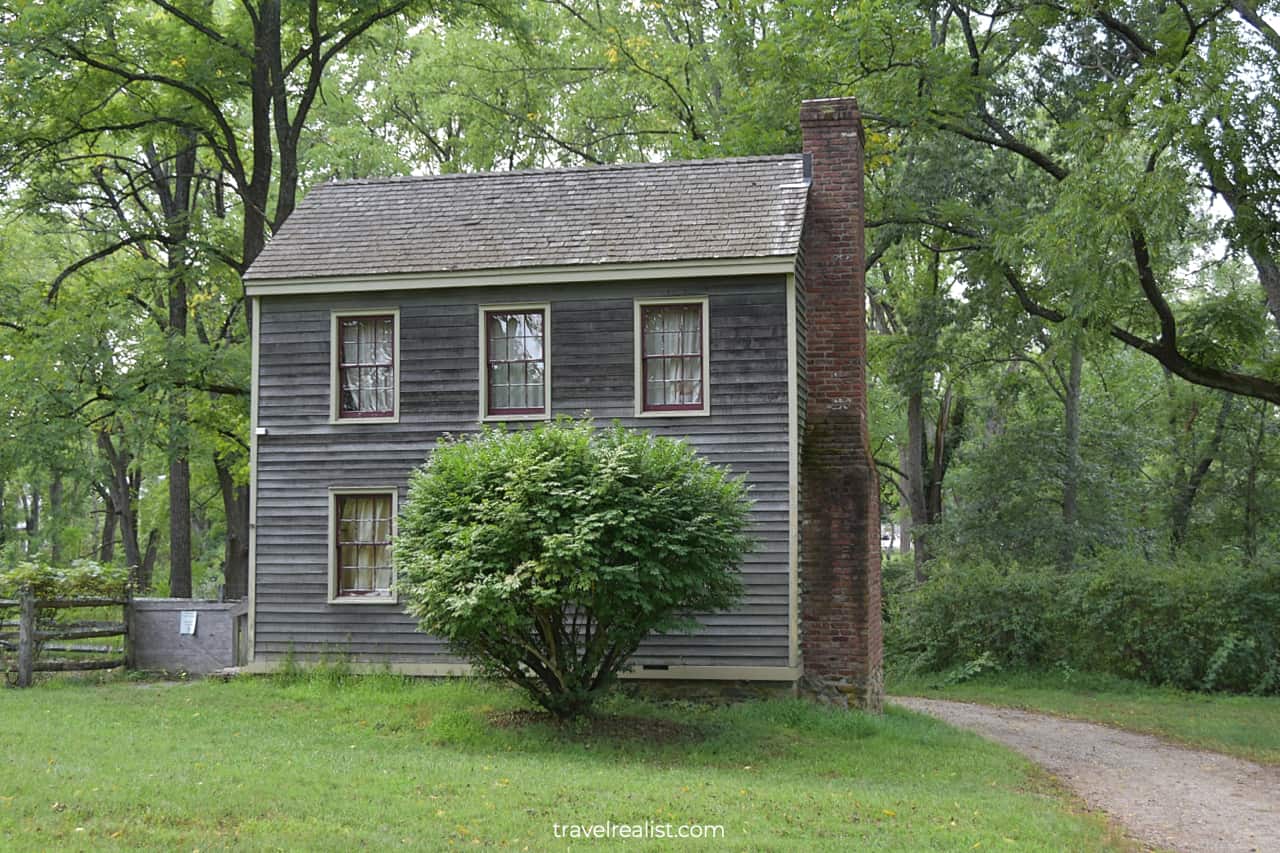
21. Visitor Center
You will arrive at the Visitor Center after you pass the Cabin, Canal Mule Barn, and Gazebo. This building looks just like the White Barn.
This will not come as a surprise. The Visitor Center is in the Seymour Smith Carriage House. This is the only carriage house that does not carry a nickname. But, in a way, this building is a “Yellow Barn”.
The Visitor Center is a great place to learn more about the history of Waterloo Village. The helpful staff will be glad to answer your questions and make your visit to the park most enjoyable.
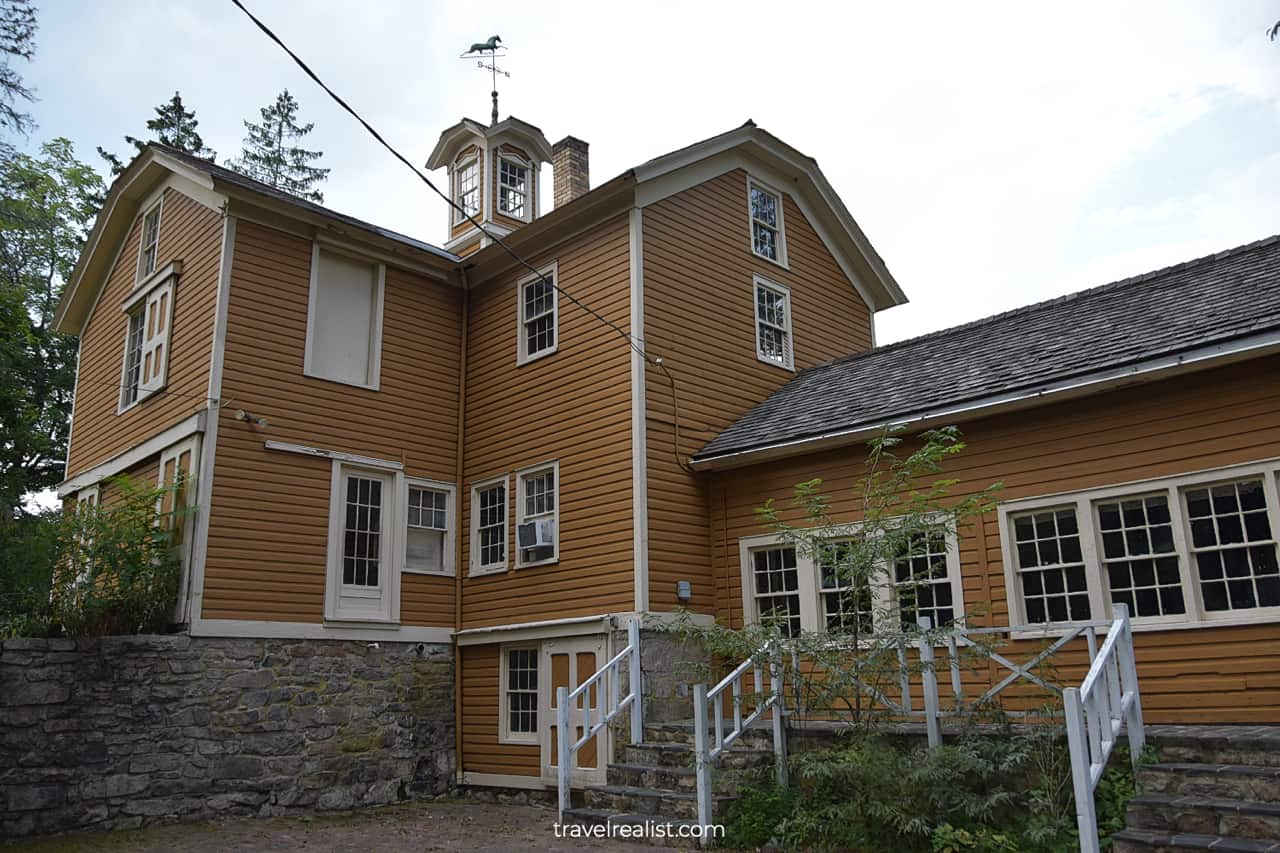
22. Pavilion & Meeting House
You will see the Pavilion & Meeting House as soon as you exit the Visitor Center. This is the largest building in Waterloo Village. It is enough to host a 250-person event.
JAM at Waterloo Weddings & Events leases this house and its surrounding area from the park. You are very likely to run into a wedding celebration if you visit the park on a summer weekend.
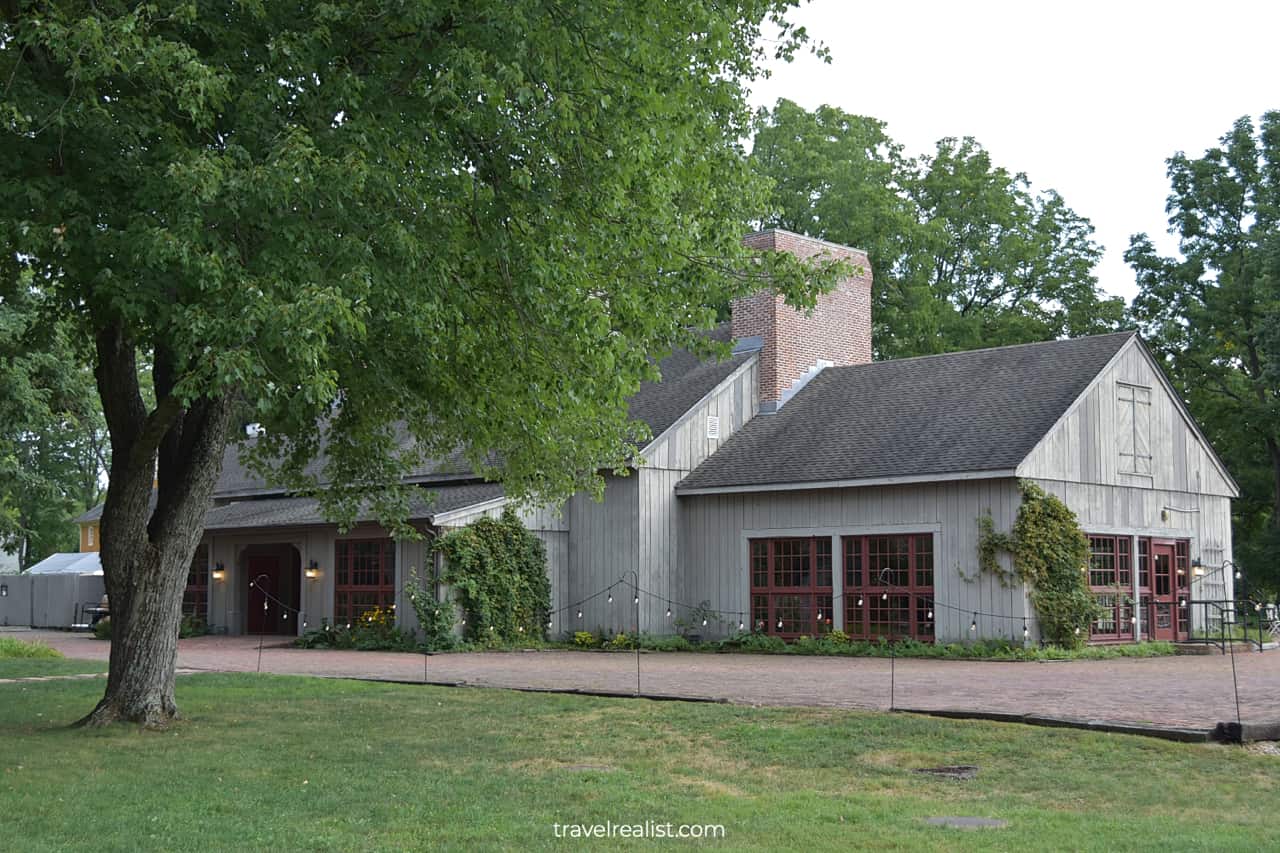
23. Living Farm
You are in for a surprise encounter as you are heading from the Pavilion & Meeting House towards the parking lot. This part of Waterloo Village is home to a living farm and garden.
The staff at Waterloo Village Historic Site tend to chickens, ducks, and geese at the farm. You will see a few apple and pear trees. A handful of vegetable plants also take a good portion of the garden.
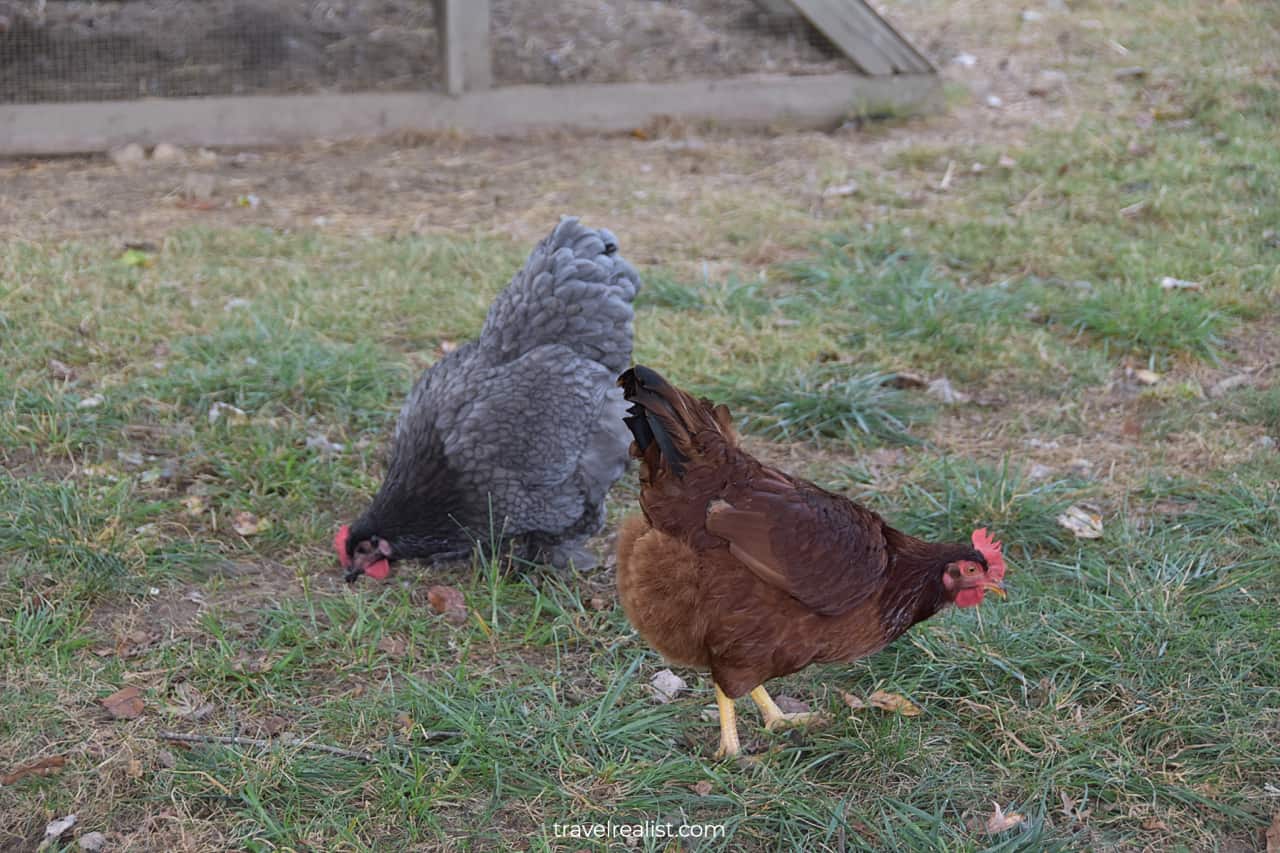
But you probably did not expect to see an alpaca in Northern New Jersey. Yet, there is one strolling the fields of Waterloo Village.
This animal is native to South America. You could find it in Columbia, Ecuador, Peru, Chile, and Argentina. Before you plan a trip to see alpacas in their natural habitat, check out a living farm in Waterloo Village.
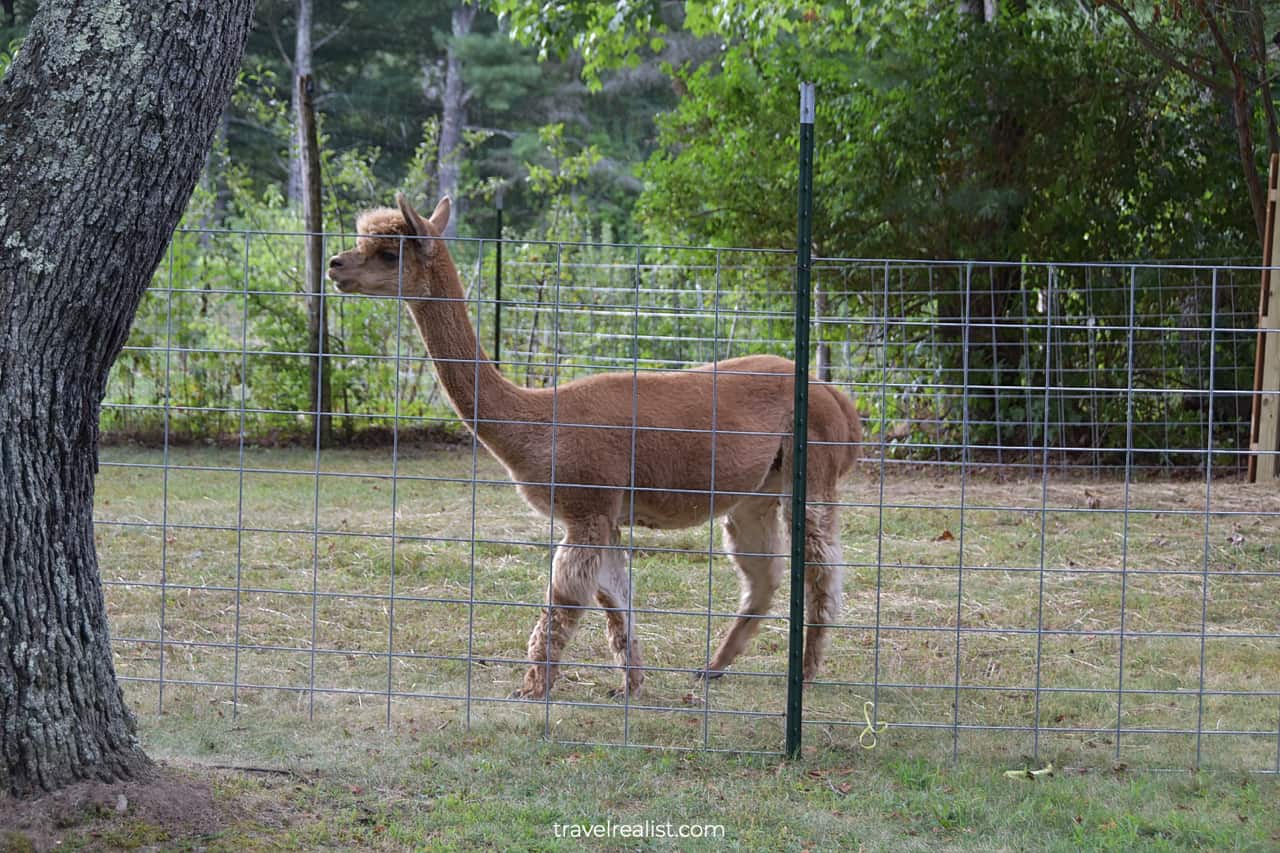
Without any doubt, this alpaca steals the show for children and adults visiting this historic site. There are always people near this animal.
While you might want to feed it, you should rather admire this alpaca from a distance. A farm is not a zoo. It is better to leave the portioning to the Waterloo Village staff.
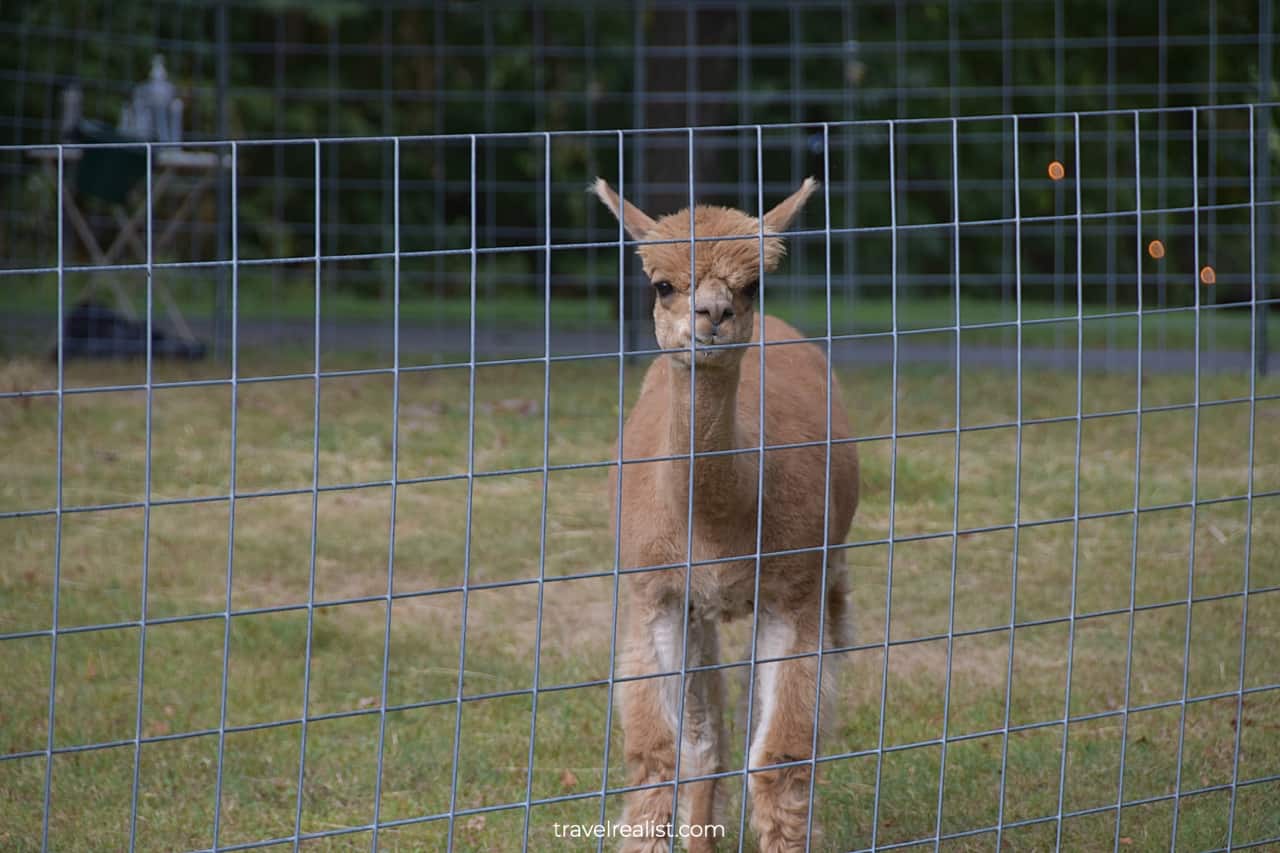
Continue with this Waterloo Village Historic Site Guide. You will learn more about ways to get to the sights, entrance requirements, and places to stay.
Getting to Waterloo Village Historic Site
Waterloo Village Historic Site is a park in Stanhope, New Jersey. The park is just off Interstate Highway I-80, about halfway between Parsippany-Troy Hills, New Jersey and Stroudsburg, Pennsylvania.
Waterloo Village is a great addition to a trip to Northern New Jersey and Northeastern Pennsylvania. You could visit this park after Hoboken or Statue of Liberty and before Delaware Water Gap or Grey Towers.
This location makes Waterloo Village an easy park to reach from New York City airports. Newark Liberty (EWR) is the closest airport, just 45 minutes from the park.
New York LaGuardia (LGA) and New York John F. Kennedy (JFK) are not much further away distance wise. But you could spend well over 1.5 hours in a car since you would need to deal with NYC traffic.
You need a rental car for visiting Waterloo Village as an out-of-state visitor. It will allow you to reach the park and explore it at your own pace.
There is one public transport route that brings you close to the park. Mt Olive station on Morris and Montclair Boonton Lines is 2.7 miles (4.3 km) from Waterloo Village. Yet, it is not a good idea to take it.
The train ride from Newark is $9.75 and takes 1.5 hours each way. There is no service on weekends. And there are no walkways on the roads from the station to the park.
The lack of pedestrian walkways is especially dangerous. International Drive and Waterloo Road have cars flying by. With a narrow shoulder you are taking a big risk walking to the park.
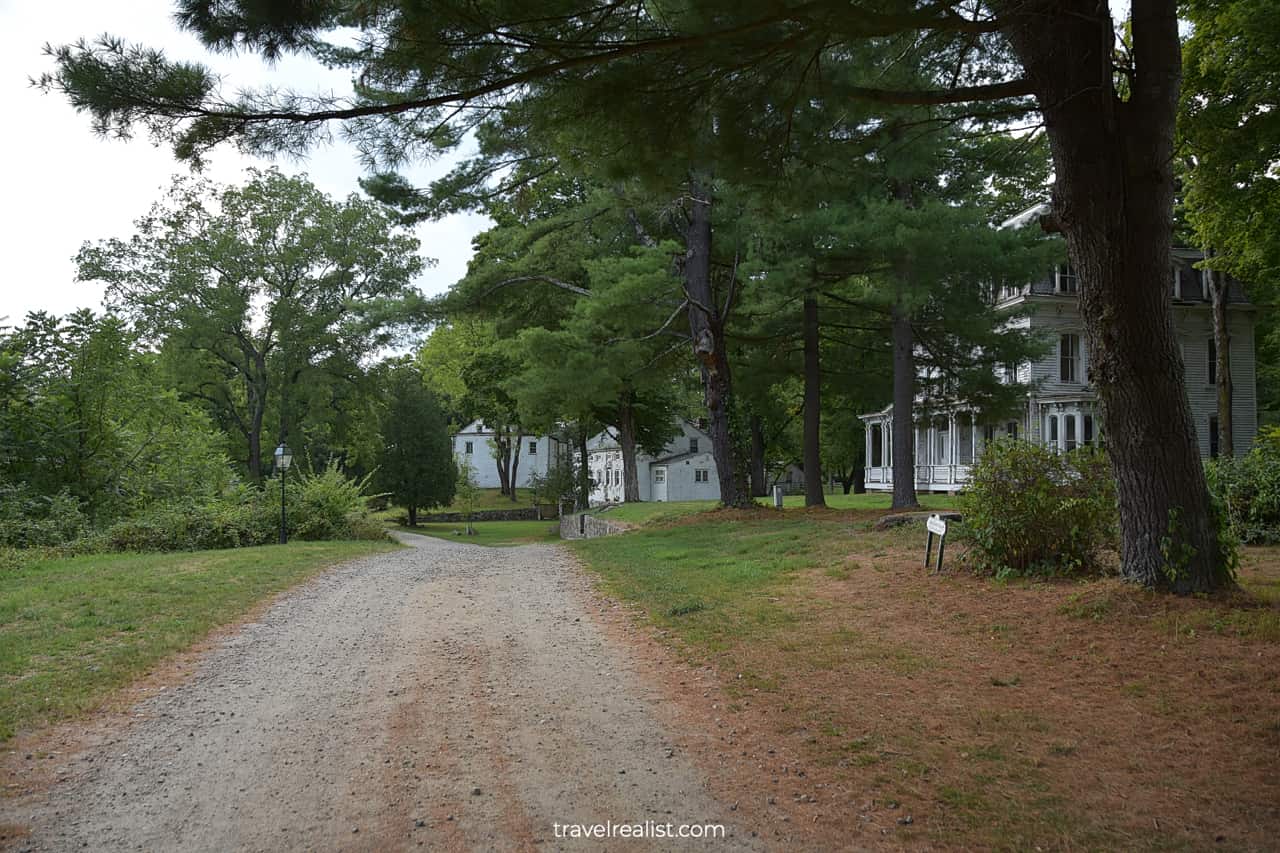
Where to Stay near Waterloo Village
You are in luck if you are looking for a place to stay near Waterloo Village Historic Site. Holiday Inn Budd Lake – Rockaway Area, an IHG Hotel is just 5 minutes east of the park.
In fact, most of your lodging options will be along Interstate Highway I-80 towards New York City Area. There are hardly any places to stay all the way till Stroudsburg in Pennsylvania.
Consider Holiday Inn Express Mount Arlington, an IHG Hotel and Homewood Suites by Hilton Dover – Rockaway. These hotels are 20 minutes from the park. They are next to the shopping and dining spots.
You would need to head further east to find more places to stay. Parsippany-Troy Hills, West Orange, and Newark are good options in New Jersey.
You could also look into staying in New York City if you so desire. While it will add more time to your exploration you will have an astonishing abundance of options to choose from.
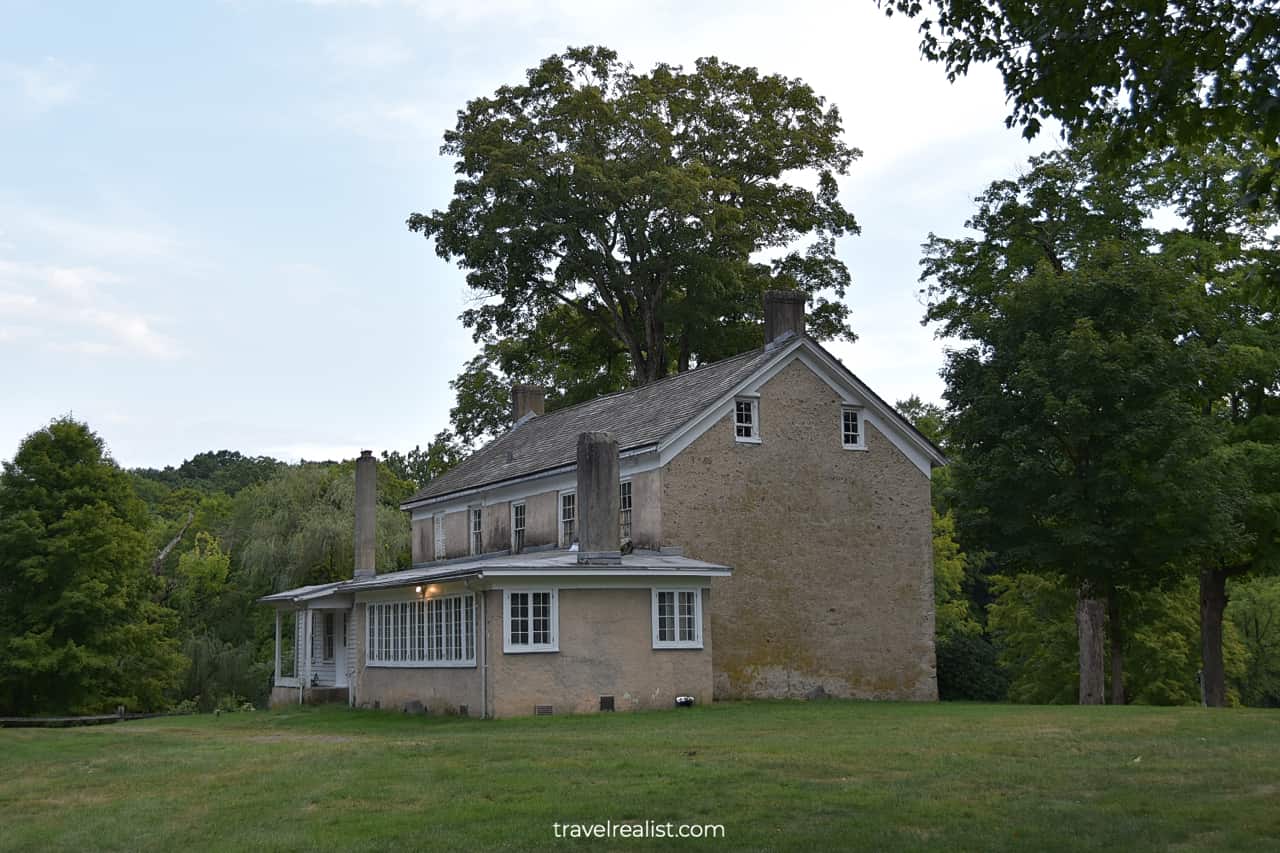
Entrance Requirements & Passes
Waterloo Village Historic Site is open for exploration from sunrise to sunset. The site offers tours on the weekends from June to September.
The tour hours are from 10 a.m. to 3:30 p.m. The Visitor Center is open during the same hours but from May to October.
There are no fees to explore the grounds of Water Village Historic Site. The tours have not been offered since the pandemic. Once the tours resume, it is a good idea to check back for pricing.
You could also choose to have your wedding celebration at Waterloo Village. The events venue has capacity for up to 250 guests. The event planning and pricing is handled via a separate company.
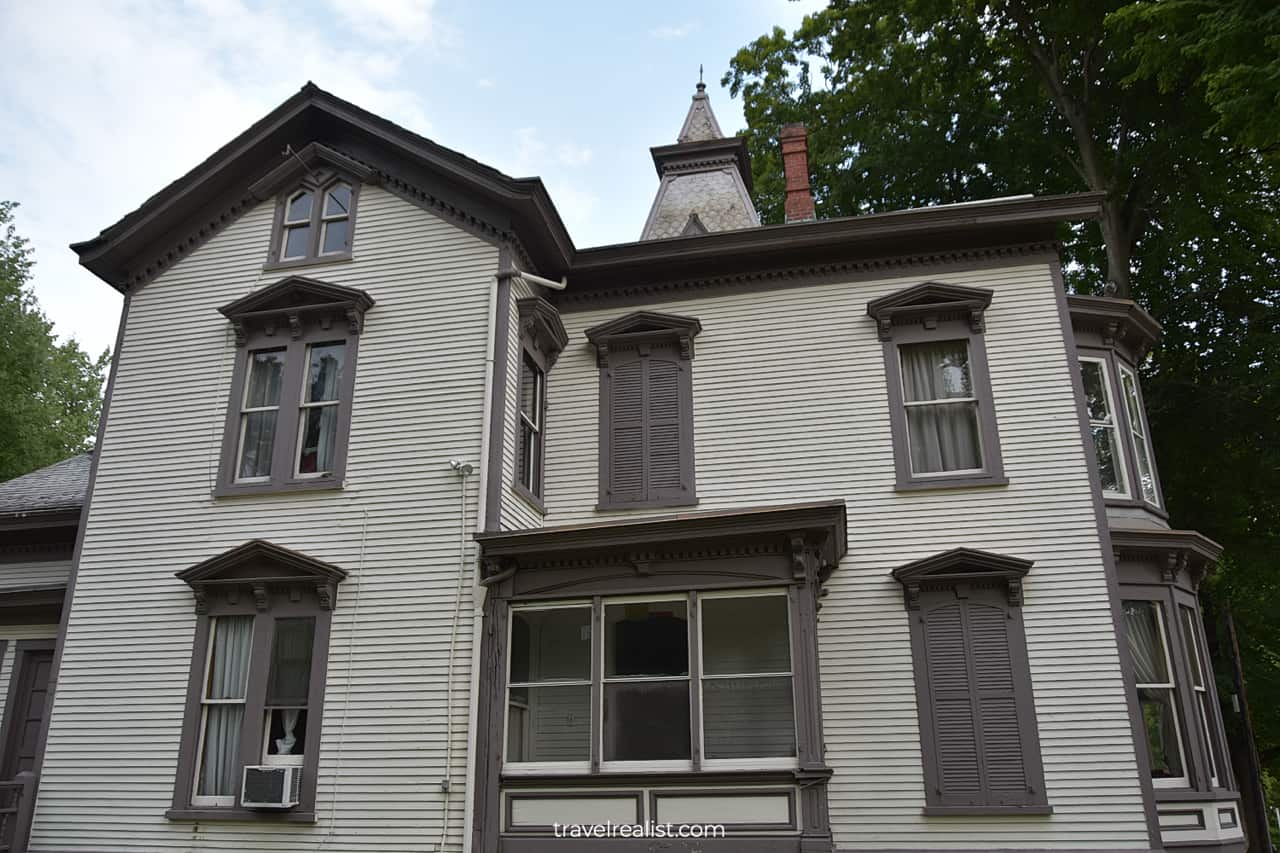
Takeaways: Waterloo Village Historic Site
Waterloo Village Historic Site is a amazing day trip destination in NYC area. You could go back 200 years just 45 minutes from Newark, New Jersey.
You could see 22 historic buildings and explore some of them from the inside. It is your chance to learn more about the history of the Morris Canal and its engineering wonders.
Blooming wildflowers and water reflections await you in Waterloo Village. Wildlife sightings and animals at the living farm round up a list of reasons to visit this scenic park.
Last but not least, this park is completely free to visit. If you like history, architecture, and scenic landscapes you should hop in your car and go to Waterloo Village.
Take a look at this Waterloo Village Historic Site Video Guide. And visit our YouTube channel for the latest videos.
Frequently Asked Questions
Waterloo Village is a Historic Site along the Morris Canal in Stanhope, New Jersey. It is a collection of 22 restored buildings. There are a few homesteads, coach houses, church, store, blacksmith shop, tavern, and mills.
Waterloo Village Historic Site is in Stanhope, NJ. The park is off Interstate Highway I-80 in Northern New Jersey. You could reach the village in under 45 minutes from Newark with normal traffic.
The first buildings in Waterloo Village date back to 1760s. The Homestead and Tavern & Hotel were built around that time.
Most of the structures in area were built after the Morris Canal was completed in 1832. The Smith’s General Store, church, homes, and coach houses date back to that period.
The village was abandoned after the closure of the Morris Canal during the Great Depression. Volunteers and state employees restored the buildings in the late 20th century.
Waterloo Village Historic Site offers plenty of activities for outdoor and history lovers:
– Walk next to the buildings from the 18th and 19th century
– Tour the Tavern & Hotel when open
– See common trade items inside the General Store
– Learn more about the Morris Canal in the Canal Museum
– Explore a mill wheel at the Sawmill and Gristmill
– Capture the Mule Bridge reflections in the water
– Spot wildlife like groundhogs at the Canal Lock
– See an alpaca and other animals at the Living Farm
– Rent a kayak to paddle on Waterloo Lake
You can walk the grounds of Waterloo Village Historic Site for free from sunrise to sunset. Tour the historic buildings and enjoy the Canal views.
Safe realist travels!


